Organisational Behaviour Report: Deliveroo Analysis
VerifiedAdded on 2023/01/16
|20
|5734
|23
Report
AI Summary
This report provides an in-depth analysis of organisational behaviour within Deliveroo, an online food delivery company. It examines how culture, power, and politics influence individual and team behaviour, focusing on various cultural types like role, task, power, and personal cultures. The report also delves into motivation theories, including content theories such as Maslow's hierarchy of needs and Herzberg's two-factor theory, and process theories like expectancy theory. Furthermore, it explores the factors that contribute to effective and ineffective teams, and discusses the concepts and philosophies of organisational behaviour that impact employees in a business setting. The report highlights how Deliveroo's management can apply these concepts to improve employee performance and overall organisational success.

Organisation and
Behaviour
Behaviour
Secure Best Marks with AI Grader
Need help grading? Try our AI Grader for instant feedback on your assignments.
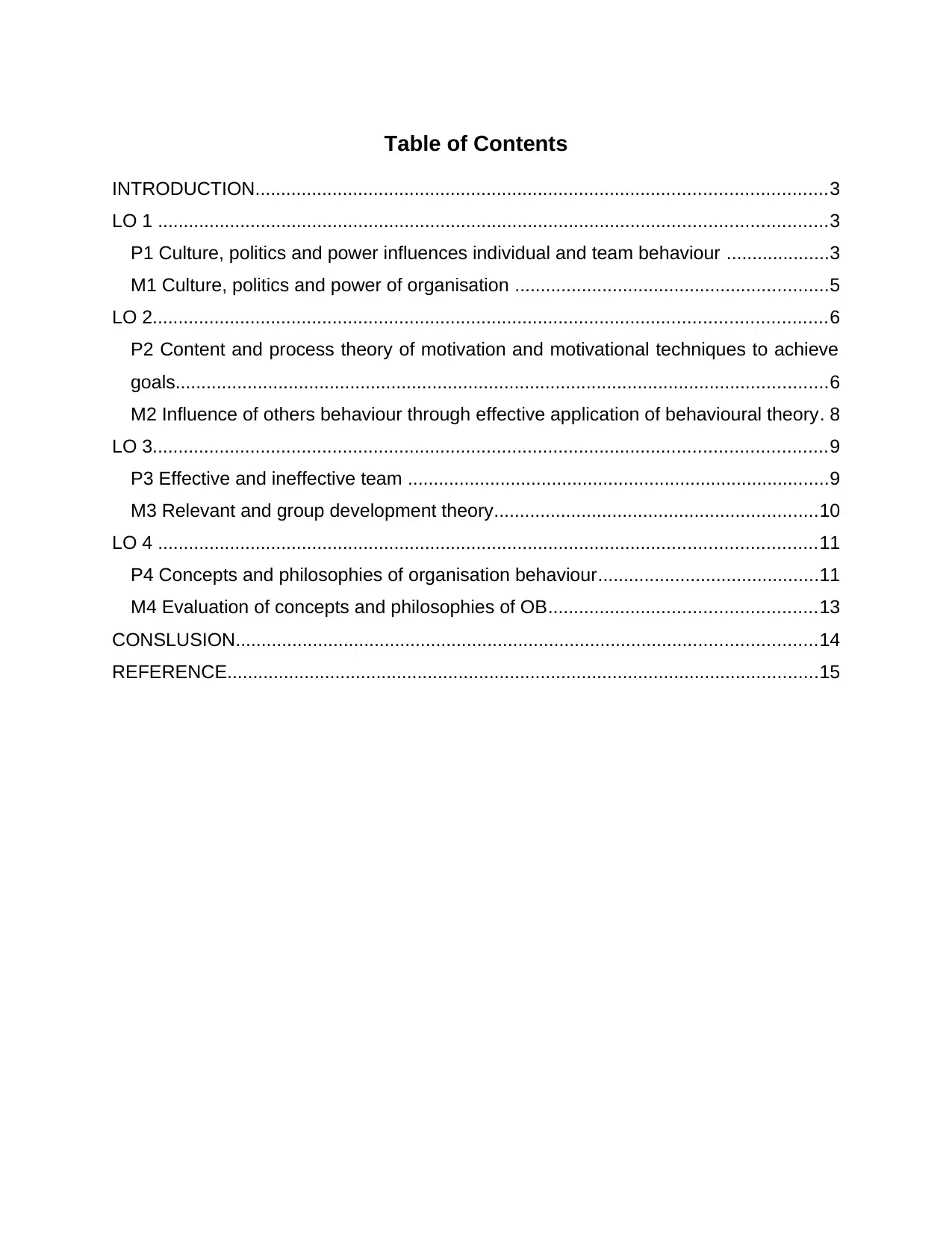
Table of Contents
INTRODUCTION...............................................................................................................3
LO 1 ..................................................................................................................................3
P1 Culture, politics and power influences individual and team behaviour ....................3
M1 Culture, politics and power of organisation .............................................................5
LO 2...................................................................................................................................6
P2 Content and process theory of motivation and motivational techniques to achieve
goals...............................................................................................................................6
M2 Influence of others behaviour through effective application of behavioural theory. 8
LO 3...................................................................................................................................9
P3 Effective and ineffective team ..................................................................................9
M3 Relevant and group development theory...............................................................10
LO 4 ................................................................................................................................11
P4 Concepts and philosophies of organisation behaviour...........................................11
M4 Evaluation of concepts and philosophies of OB....................................................13
CONSLUSION.................................................................................................................14
REFERENCE...................................................................................................................15
INTRODUCTION...............................................................................................................3
LO 1 ..................................................................................................................................3
P1 Culture, politics and power influences individual and team behaviour ....................3
M1 Culture, politics and power of organisation .............................................................5
LO 2...................................................................................................................................6
P2 Content and process theory of motivation and motivational techniques to achieve
goals...............................................................................................................................6
M2 Influence of others behaviour through effective application of behavioural theory. 8
LO 3...................................................................................................................................9
P3 Effective and ineffective team ..................................................................................9
M3 Relevant and group development theory...............................................................10
LO 4 ................................................................................................................................11
P4 Concepts and philosophies of organisation behaviour...........................................11
M4 Evaluation of concepts and philosophies of OB....................................................13
CONSLUSION.................................................................................................................14
REFERENCE...................................................................................................................15

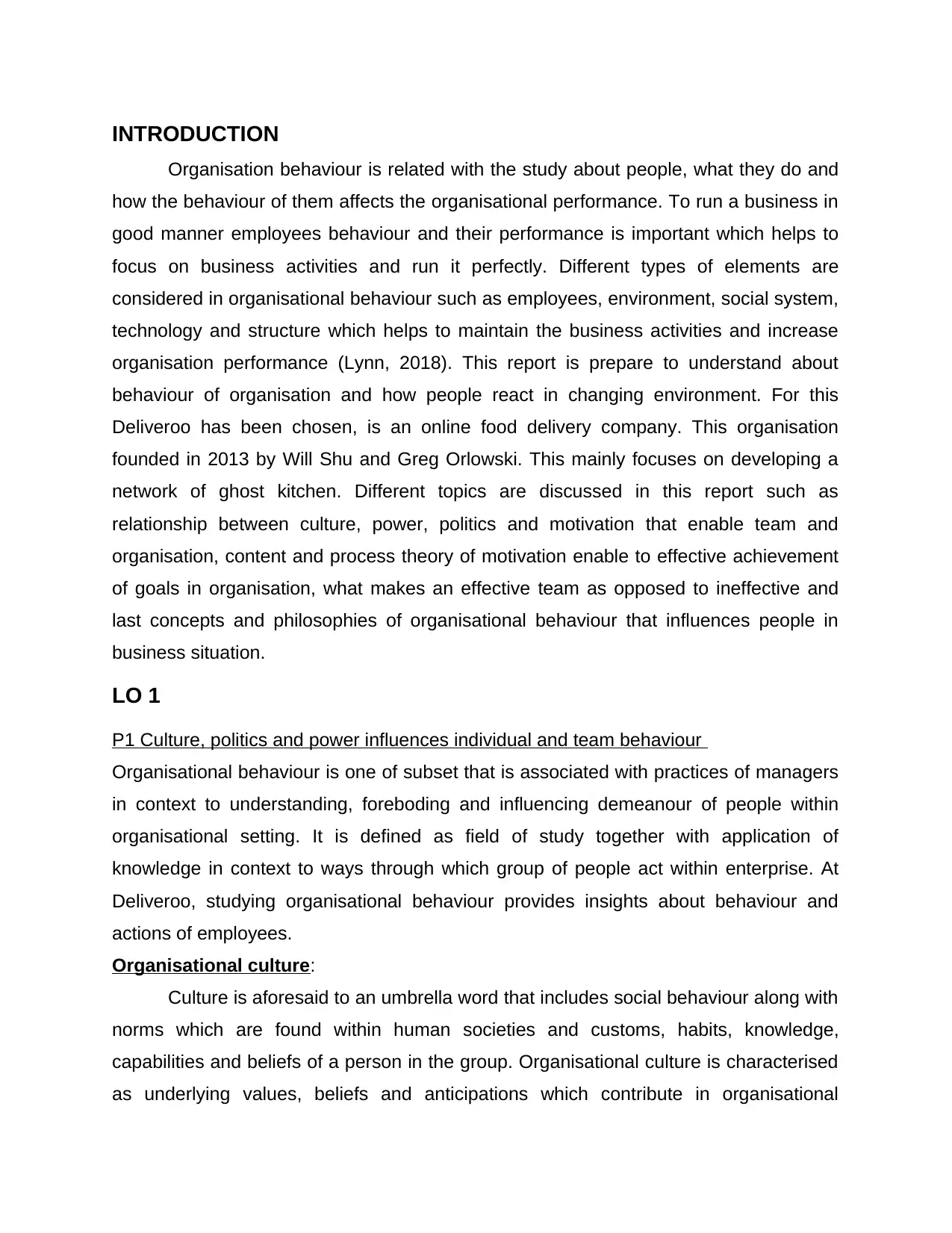
INTRODUCTION
Organisation behaviour is related with the study about people, what they do and
how the behaviour of them affects the organisational performance. To run a business in
good manner employees behaviour and their performance is important which helps to
focus on business activities and run it perfectly. Different types of elements are
considered in organisational behaviour such as employees, environment, social system,
technology and structure which helps to maintain the business activities and increase
organisation performance (Lynn, 2018). This report is prepare to understand about
behaviour of organisation and how people react in changing environment. For this
Deliveroo has been chosen, is an online food delivery company. This organisation
founded in 2013 by Will Shu and Greg Orlowski. This mainly focuses on developing a
network of ghost kitchen. Different topics are discussed in this report such as
relationship between culture, power, politics and motivation that enable team and
organisation, content and process theory of motivation enable to effective achievement
of goals in organisation, what makes an effective team as opposed to ineffective and
last concepts and philosophies of organisational behaviour that influences people in
business situation.
LO 1
P1 Culture, politics and power influences individual and team behaviour
Organisational behaviour is one of subset that is associated with practices of managers
in context to understanding, foreboding and influencing demeanour of people within
organisational setting. It is defined as field of study together with application of
knowledge in context to ways through which group of people act within enterprise. At
Deliveroo, studying organisational behaviour provides insights about behaviour and
actions of employees.
Organisational culture:
Culture is aforesaid to an umbrella word that includes social behaviour along with
norms which are found within human societies and customs, habits, knowledge,
capabilities and beliefs of a person in the group. Organisational culture is characterised
as underlying values, beliefs and anticipations which contribute in organisational
Organisation behaviour is related with the study about people, what they do and
how the behaviour of them affects the organisational performance. To run a business in
good manner employees behaviour and their performance is important which helps to
focus on business activities and run it perfectly. Different types of elements are
considered in organisational behaviour such as employees, environment, social system,
technology and structure which helps to maintain the business activities and increase
organisation performance (Lynn, 2018). This report is prepare to understand about
behaviour of organisation and how people react in changing environment. For this
Deliveroo has been chosen, is an online food delivery company. This organisation
founded in 2013 by Will Shu and Greg Orlowski. This mainly focuses on developing a
network of ghost kitchen. Different topics are discussed in this report such as
relationship between culture, power, politics and motivation that enable team and
organisation, content and process theory of motivation enable to effective achievement
of goals in organisation, what makes an effective team as opposed to ineffective and
last concepts and philosophies of organisational behaviour that influences people in
business situation.
LO 1
P1 Culture, politics and power influences individual and team behaviour
Organisational behaviour is one of subset that is associated with practices of managers
in context to understanding, foreboding and influencing demeanour of people within
organisational setting. It is defined as field of study together with application of
knowledge in context to ways through which group of people act within enterprise. At
Deliveroo, studying organisational behaviour provides insights about behaviour and
actions of employees.
Organisational culture:
Culture is aforesaid to an umbrella word that includes social behaviour along with
norms which are found within human societies and customs, habits, knowledge,
capabilities and beliefs of a person in the group. Organisational culture is characterised
as underlying values, beliefs and anticipations which contribute in organisational
Secure Best Marks with AI Grader
Need help grading? Try our AI Grader for instant feedback on your assignments.
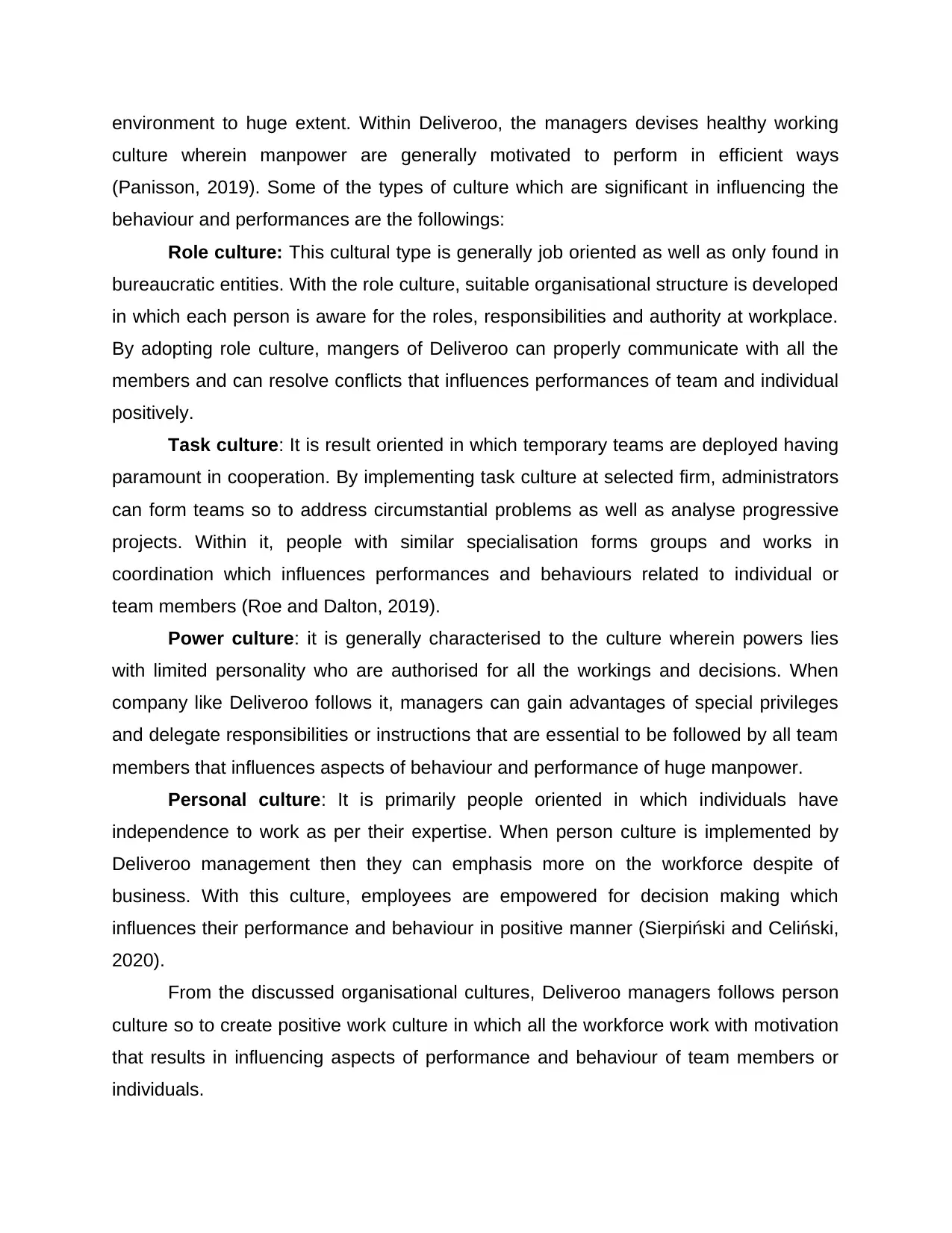
environment to huge extent. Within Deliveroo, the managers devises healthy working
culture wherein manpower are generally motivated to perform in efficient ways
(Panisson, 2019). Some of the types of culture which are significant in influencing the
behaviour and performances are the followings:
Role culture: This cultural type is generally job oriented as well as only found in
bureaucratic entities. With the role culture, suitable organisational structure is developed
in which each person is aware for the roles, responsibilities and authority at workplace.
By adopting role culture, mangers of Deliveroo can properly communicate with all the
members and can resolve conflicts that influences performances of team and individual
positively.
Task culture: It is result oriented in which temporary teams are deployed having
paramount in cooperation. By implementing task culture at selected firm, administrators
can form teams so to address circumstantial problems as well as analyse progressive
projects. Within it, people with similar specialisation forms groups and works in
coordination which influences performances and behaviours related to individual or
team members (Roe and Dalton, 2019).
Power culture: it is generally characterised to the culture wherein powers lies
with limited personality who are authorised for all the workings and decisions. When
company like Deliveroo follows it, managers can gain advantages of special privileges
and delegate responsibilities or instructions that are essential to be followed by all team
members that influences aspects of behaviour and performance of huge manpower.
Personal culture: It is primarily people oriented in which individuals have
independence to work as per their expertise. When person culture is implemented by
Deliveroo management then they can emphasis more on the workforce despite of
business. With this culture, employees are empowered for decision making which
influences their performance and behaviour in positive manner (Sierpiński and Celiński,
2020).
From the discussed organisational cultures, Deliveroo managers follows person
culture so to create positive work culture in which all the workforce work with motivation
that results in influencing aspects of performance and behaviour of team members or
individuals.
culture wherein manpower are generally motivated to perform in efficient ways
(Panisson, 2019). Some of the types of culture which are significant in influencing the
behaviour and performances are the followings:
Role culture: This cultural type is generally job oriented as well as only found in
bureaucratic entities. With the role culture, suitable organisational structure is developed
in which each person is aware for the roles, responsibilities and authority at workplace.
By adopting role culture, mangers of Deliveroo can properly communicate with all the
members and can resolve conflicts that influences performances of team and individual
positively.
Task culture: It is result oriented in which temporary teams are deployed having
paramount in cooperation. By implementing task culture at selected firm, administrators
can form teams so to address circumstantial problems as well as analyse progressive
projects. Within it, people with similar specialisation forms groups and works in
coordination which influences performances and behaviours related to individual or
team members (Roe and Dalton, 2019).
Power culture: it is generally characterised to the culture wherein powers lies
with limited personality who are authorised for all the workings and decisions. When
company like Deliveroo follows it, managers can gain advantages of special privileges
and delegate responsibilities or instructions that are essential to be followed by all team
members that influences aspects of behaviour and performance of huge manpower.
Personal culture: It is primarily people oriented in which individuals have
independence to work as per their expertise. When person culture is implemented by
Deliveroo management then they can emphasis more on the workforce despite of
business. With this culture, employees are empowered for decision making which
influences their performance and behaviour in positive manner (Sierpiński and Celiński,
2020).
From the discussed organisational cultures, Deliveroo managers follows person
culture so to create positive work culture in which all the workforce work with motivation
that results in influencing aspects of performance and behaviour of team members or
individuals.
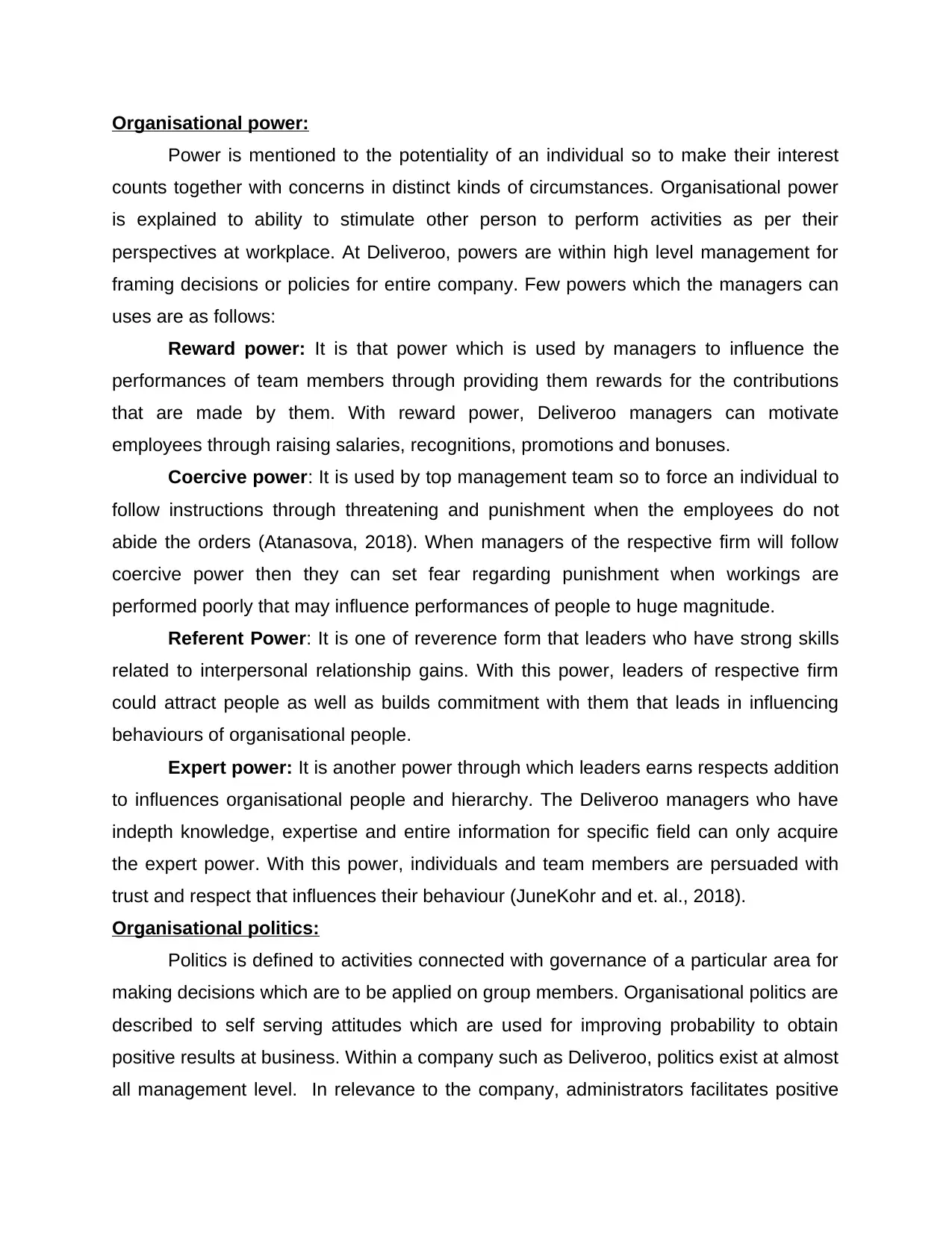
Organisational power:
Power is mentioned to the potentiality of an individual so to make their interest
counts together with concerns in distinct kinds of circumstances. Organisational power
is explained to ability to stimulate other person to perform activities as per their
perspectives at workplace. At Deliveroo, powers are within high level management for
framing decisions or policies for entire company. Few powers which the managers can
uses are as follows:
Reward power: It is that power which is used by managers to influence the
performances of team members through providing them rewards for the contributions
that are made by them. With reward power, Deliveroo managers can motivate
employees through raising salaries, recognitions, promotions and bonuses.
Coercive power: It is used by top management team so to force an individual to
follow instructions through threatening and punishment when the employees do not
abide the orders (Atanasova, 2018). When managers of the respective firm will follow
coercive power then they can set fear regarding punishment when workings are
performed poorly that may influence performances of people to huge magnitude.
Referent Power: It is one of reverence form that leaders who have strong skills
related to interpersonal relationship gains. With this power, leaders of respective firm
could attract people as well as builds commitment with them that leads in influencing
behaviours of organisational people.
Expert power: It is another power through which leaders earns respects addition
to influences organisational people and hierarchy. The Deliveroo managers who have
indepth knowledge, expertise and entire information for specific field can only acquire
the expert power. With this power, individuals and team members are persuaded with
trust and respect that influences their behaviour (JuneKohr and et. al., 2018).
Organisational politics:
Politics is defined to activities connected with governance of a particular area for
making decisions which are to be applied on group members. Organisational politics are
described to self serving attitudes which are used for improving probability to obtain
positive results at business. Within a company such as Deliveroo, politics exist at almost
all management level. In relevance to the company, administrators facilitates positive
Power is mentioned to the potentiality of an individual so to make their interest
counts together with concerns in distinct kinds of circumstances. Organisational power
is explained to ability to stimulate other person to perform activities as per their
perspectives at workplace. At Deliveroo, powers are within high level management for
framing decisions or policies for entire company. Few powers which the managers can
uses are as follows:
Reward power: It is that power which is used by managers to influence the
performances of team members through providing them rewards for the contributions
that are made by them. With reward power, Deliveroo managers can motivate
employees through raising salaries, recognitions, promotions and bonuses.
Coercive power: It is used by top management team so to force an individual to
follow instructions through threatening and punishment when the employees do not
abide the orders (Atanasova, 2018). When managers of the respective firm will follow
coercive power then they can set fear regarding punishment when workings are
performed poorly that may influence performances of people to huge magnitude.
Referent Power: It is one of reverence form that leaders who have strong skills
related to interpersonal relationship gains. With this power, leaders of respective firm
could attract people as well as builds commitment with them that leads in influencing
behaviours of organisational people.
Expert power: It is another power through which leaders earns respects addition
to influences organisational people and hierarchy. The Deliveroo managers who have
indepth knowledge, expertise and entire information for specific field can only acquire
the expert power. With this power, individuals and team members are persuaded with
trust and respect that influences their behaviour (JuneKohr and et. al., 2018).
Organisational politics:
Politics is defined to activities connected with governance of a particular area for
making decisions which are to be applied on group members. Organisational politics are
described to self serving attitudes which are used for improving probability to obtain
positive results at business. Within a company such as Deliveroo, politics exist at almost
all management level. In relevance to the company, administrators facilitates positive
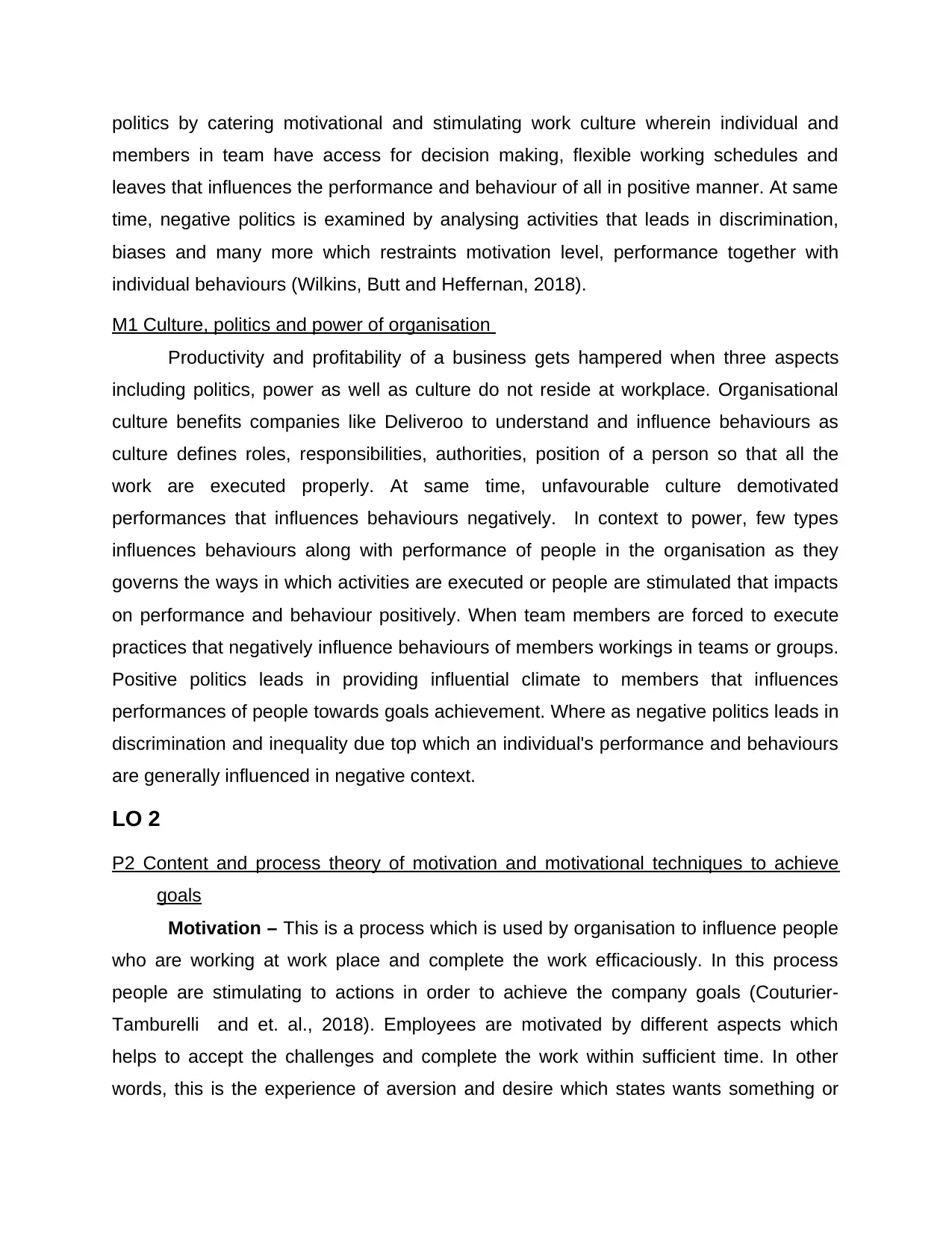
politics by catering motivational and stimulating work culture wherein individual and
members in team have access for decision making, flexible working schedules and
leaves that influences the performance and behaviour of all in positive manner. At same
time, negative politics is examined by analysing activities that leads in discrimination,
biases and many more which restraints motivation level, performance together with
individual behaviours (Wilkins, Butt and Heffernan, 2018).
M1 Culture, politics and power of organisation
Productivity and profitability of a business gets hampered when three aspects
including politics, power as well as culture do not reside at workplace. Organisational
culture benefits companies like Deliveroo to understand and influence behaviours as
culture defines roles, responsibilities, authorities, position of a person so that all the
work are executed properly. At same time, unfavourable culture demotivated
performances that influences behaviours negatively. In context to power, few types
influences behaviours along with performance of people in the organisation as they
governs the ways in which activities are executed or people are stimulated that impacts
on performance and behaviour positively. When team members are forced to execute
practices that negatively influence behaviours of members workings in teams or groups.
Positive politics leads in providing influential climate to members that influences
performances of people towards goals achievement. Where as negative politics leads in
discrimination and inequality due top which an individual's performance and behaviours
are generally influenced in negative context.
LO 2
P2 Content and process theory of motivation and motivational techniques to achieve
goals
Motivation – This is a process which is used by organisation to influence people
who are working at work place and complete the work efficaciously. In this process
people are stimulating to actions in order to achieve the company goals (Couturier-
Tamburelli and et. al., 2018). Employees are motivated by different aspects which
helps to accept the challenges and complete the work within sufficient time. In other
words, this is the experience of aversion and desire which states wants something or
members in team have access for decision making, flexible working schedules and
leaves that influences the performance and behaviour of all in positive manner. At same
time, negative politics is examined by analysing activities that leads in discrimination,
biases and many more which restraints motivation level, performance together with
individual behaviours (Wilkins, Butt and Heffernan, 2018).
M1 Culture, politics and power of organisation
Productivity and profitability of a business gets hampered when three aspects
including politics, power as well as culture do not reside at workplace. Organisational
culture benefits companies like Deliveroo to understand and influence behaviours as
culture defines roles, responsibilities, authorities, position of a person so that all the
work are executed properly. At same time, unfavourable culture demotivated
performances that influences behaviours negatively. In context to power, few types
influences behaviours along with performance of people in the organisation as they
governs the ways in which activities are executed or people are stimulated that impacts
on performance and behaviour positively. When team members are forced to execute
practices that negatively influence behaviours of members workings in teams or groups.
Positive politics leads in providing influential climate to members that influences
performances of people towards goals achievement. Where as negative politics leads in
discrimination and inequality due top which an individual's performance and behaviours
are generally influenced in negative context.
LO 2
P2 Content and process theory of motivation and motivational techniques to achieve
goals
Motivation – This is a process which is used by organisation to influence people
who are working at work place and complete the work efficaciously. In this process
people are stimulating to actions in order to achieve the company goals (Couturier-
Tamburelli and et. al., 2018). Employees are motivated by different aspects which
helps to accept the challenges and complete the work within sufficient time. In other
words, this is the experience of aversion and desire which states wants something or
Paraphrase This Document
Need a fresh take? Get an instant paraphrase of this document with our AI Paraphraser
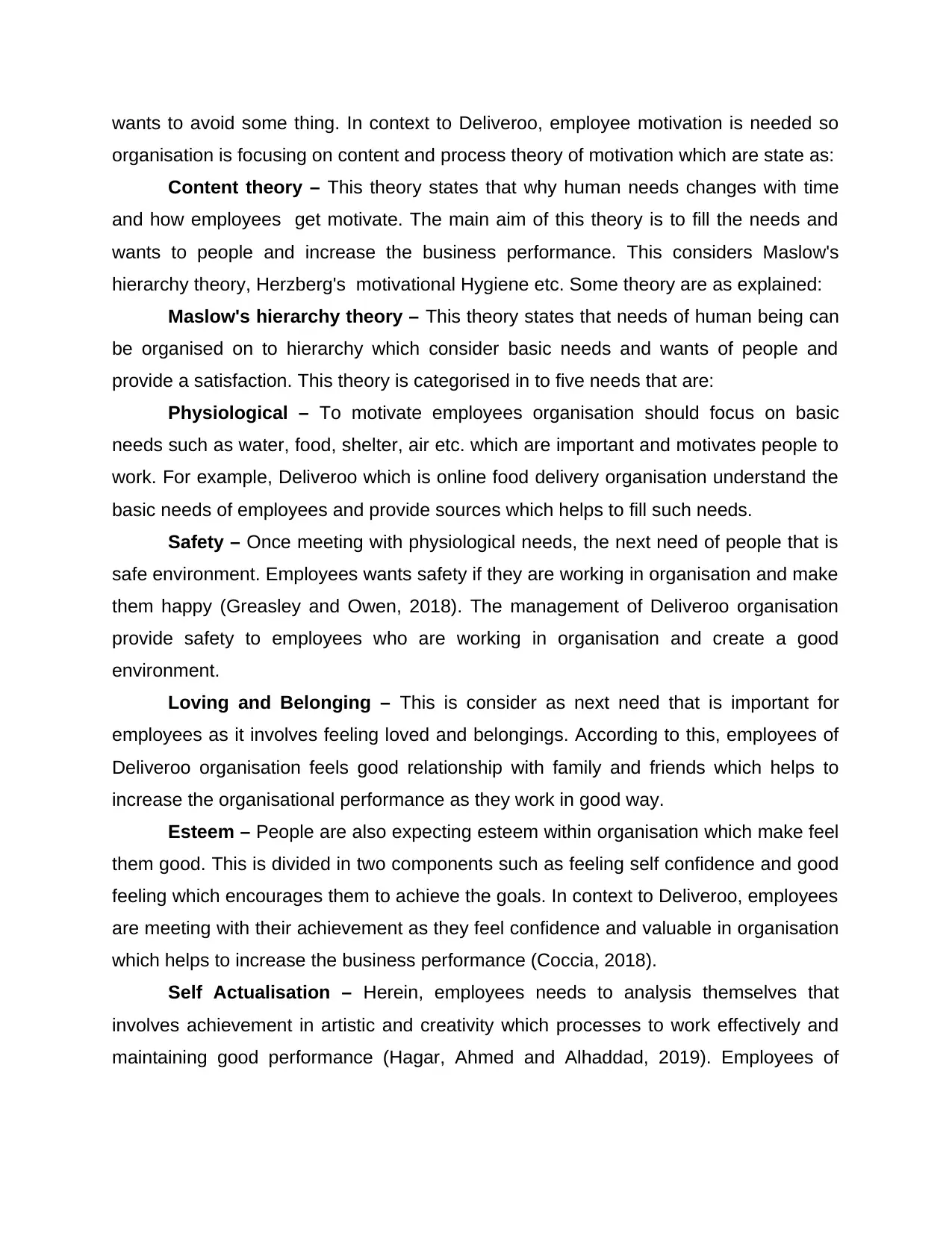
wants to avoid some thing. In context to Deliveroo, employee motivation is needed so
organisation is focusing on content and process theory of motivation which are state as:
Content theory – This theory states that why human needs changes with time
and how employees get motivate. The main aim of this theory is to fill the needs and
wants to people and increase the business performance. This considers Maslow's
hierarchy theory, Herzberg's motivational Hygiene etc. Some theory are as explained:
Maslow's hierarchy theory – This theory states that needs of human being can
be organised on to hierarchy which consider basic needs and wants of people and
provide a satisfaction. This theory is categorised in to five needs that are:
Physiological – To motivate employees organisation should focus on basic
needs such as water, food, shelter, air etc. which are important and motivates people to
work. For example, Deliveroo which is online food delivery organisation understand the
basic needs of employees and provide sources which helps to fill such needs.
Safety – Once meeting with physiological needs, the next need of people that is
safe environment. Employees wants safety if they are working in organisation and make
them happy (Greasley and Owen, 2018). The management of Deliveroo organisation
provide safety to employees who are working in organisation and create a good
environment.
Loving and Belonging – This is consider as next need that is important for
employees as it involves feeling loved and belongings. According to this, employees of
Deliveroo organisation feels good relationship with family and friends which helps to
increase the organisational performance as they work in good way.
Esteem – People are also expecting esteem within organisation which make feel
them good. This is divided in two components such as feeling self confidence and good
feeling which encourages them to achieve the goals. In context to Deliveroo, employees
are meeting with their achievement as they feel confidence and valuable in organisation
which helps to increase the business performance (Coccia, 2018).
Self Actualisation – Herein, employees needs to analysis themselves that
involves achievement in artistic and creativity which processes to work effectively and
maintaining good performance (Hagar, Ahmed and Alhaddad, 2019). Employees of
organisation is focusing on content and process theory of motivation which are state as:
Content theory – This theory states that why human needs changes with time
and how employees get motivate. The main aim of this theory is to fill the needs and
wants to people and increase the business performance. This considers Maslow's
hierarchy theory, Herzberg's motivational Hygiene etc. Some theory are as explained:
Maslow's hierarchy theory – This theory states that needs of human being can
be organised on to hierarchy which consider basic needs and wants of people and
provide a satisfaction. This theory is categorised in to five needs that are:
Physiological – To motivate employees organisation should focus on basic
needs such as water, food, shelter, air etc. which are important and motivates people to
work. For example, Deliveroo which is online food delivery organisation understand the
basic needs of employees and provide sources which helps to fill such needs.
Safety – Once meeting with physiological needs, the next need of people that is
safe environment. Employees wants safety if they are working in organisation and make
them happy (Greasley and Owen, 2018). The management of Deliveroo organisation
provide safety to employees who are working in organisation and create a good
environment.
Loving and Belonging – This is consider as next need that is important for
employees as it involves feeling loved and belongings. According to this, employees of
Deliveroo organisation feels good relationship with family and friends which helps to
increase the organisational performance as they work in good way.
Esteem – People are also expecting esteem within organisation which make feel
them good. This is divided in two components such as feeling self confidence and good
feeling which encourages them to achieve the goals. In context to Deliveroo, employees
are meeting with their achievement as they feel confidence and valuable in organisation
which helps to increase the business performance (Coccia, 2018).
Self Actualisation – Herein, employees needs to analysis themselves that
involves achievement in artistic and creativity which processes to work effectively and
maintaining good performance (Hagar, Ahmed and Alhaddad, 2019). Employees of
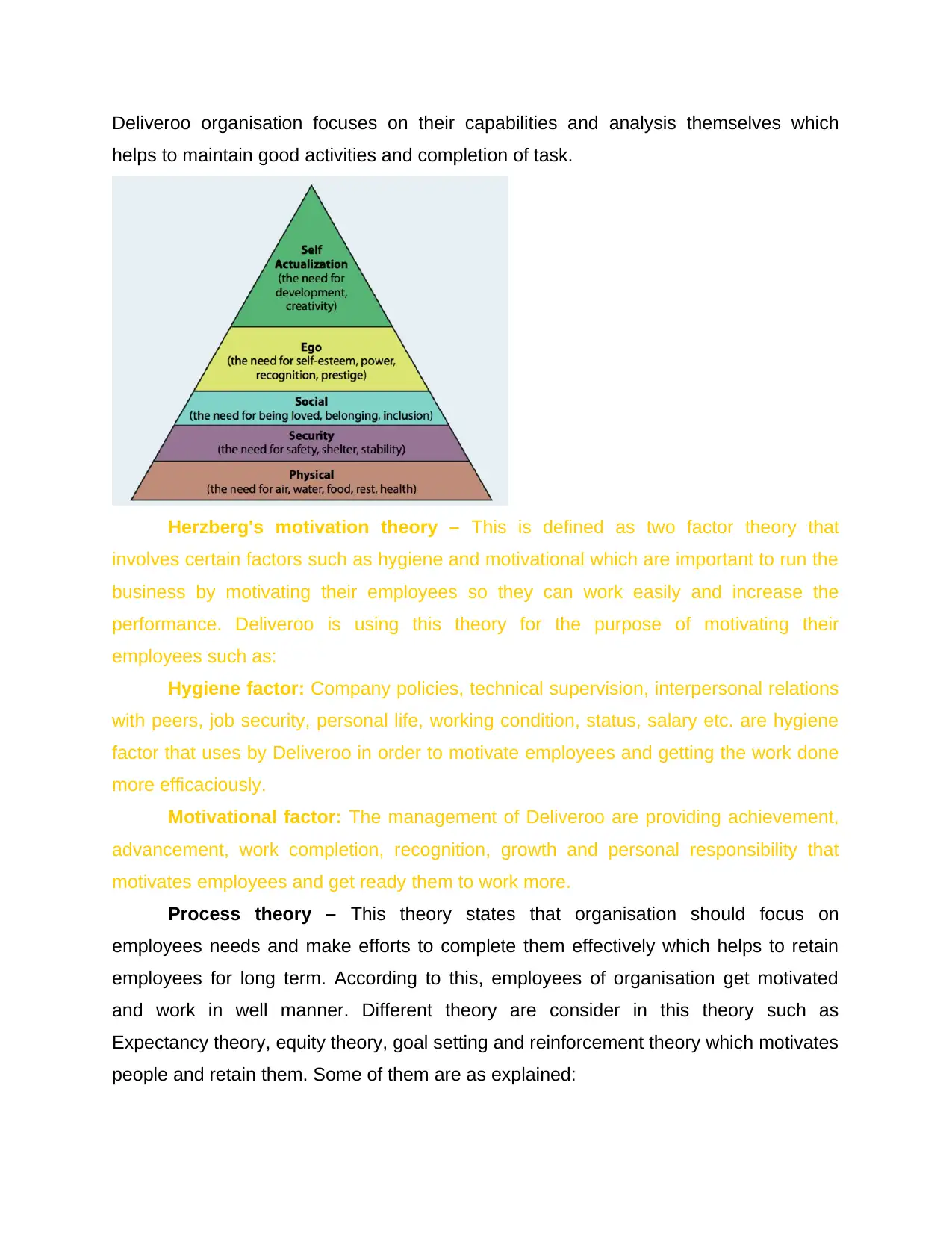
Deliveroo organisation focuses on their capabilities and analysis themselves which
helps to maintain good activities and completion of task.
Herzberg's motivation theory – This is defined as two factor theory that
involves certain factors such as hygiene and motivational which are important to run the
business by motivating their employees so they can work easily and increase the
performance. Deliveroo is using this theory for the purpose of motivating their
employees such as:
Hygiene factor: Company policies, technical supervision, interpersonal relations
with peers, job security, personal life, working condition, status, salary etc. are hygiene
factor that uses by Deliveroo in order to motivate employees and getting the work done
more efficaciously.
Motivational factor: The management of Deliveroo are providing achievement,
advancement, work completion, recognition, growth and personal responsibility that
motivates employees and get ready them to work more.
Process theory – This theory states that organisation should focus on
employees needs and make efforts to complete them effectively which helps to retain
employees for long term. According to this, employees of organisation get motivated
and work in well manner. Different theory are consider in this theory such as
Expectancy theory, equity theory, goal setting and reinforcement theory which motivates
people and retain them. Some of them are as explained:
helps to maintain good activities and completion of task.
Herzberg's motivation theory – This is defined as two factor theory that
involves certain factors such as hygiene and motivational which are important to run the
business by motivating their employees so they can work easily and increase the
performance. Deliveroo is using this theory for the purpose of motivating their
employees such as:
Hygiene factor: Company policies, technical supervision, interpersonal relations
with peers, job security, personal life, working condition, status, salary etc. are hygiene
factor that uses by Deliveroo in order to motivate employees and getting the work done
more efficaciously.
Motivational factor: The management of Deliveroo are providing achievement,
advancement, work completion, recognition, growth and personal responsibility that
motivates employees and get ready them to work more.
Process theory – This theory states that organisation should focus on
employees needs and make efforts to complete them effectively which helps to retain
employees for long term. According to this, employees of organisation get motivated
and work in well manner. Different theory are consider in this theory such as
Expectancy theory, equity theory, goal setting and reinforcement theory which motivates
people and retain them. Some of them are as explained:
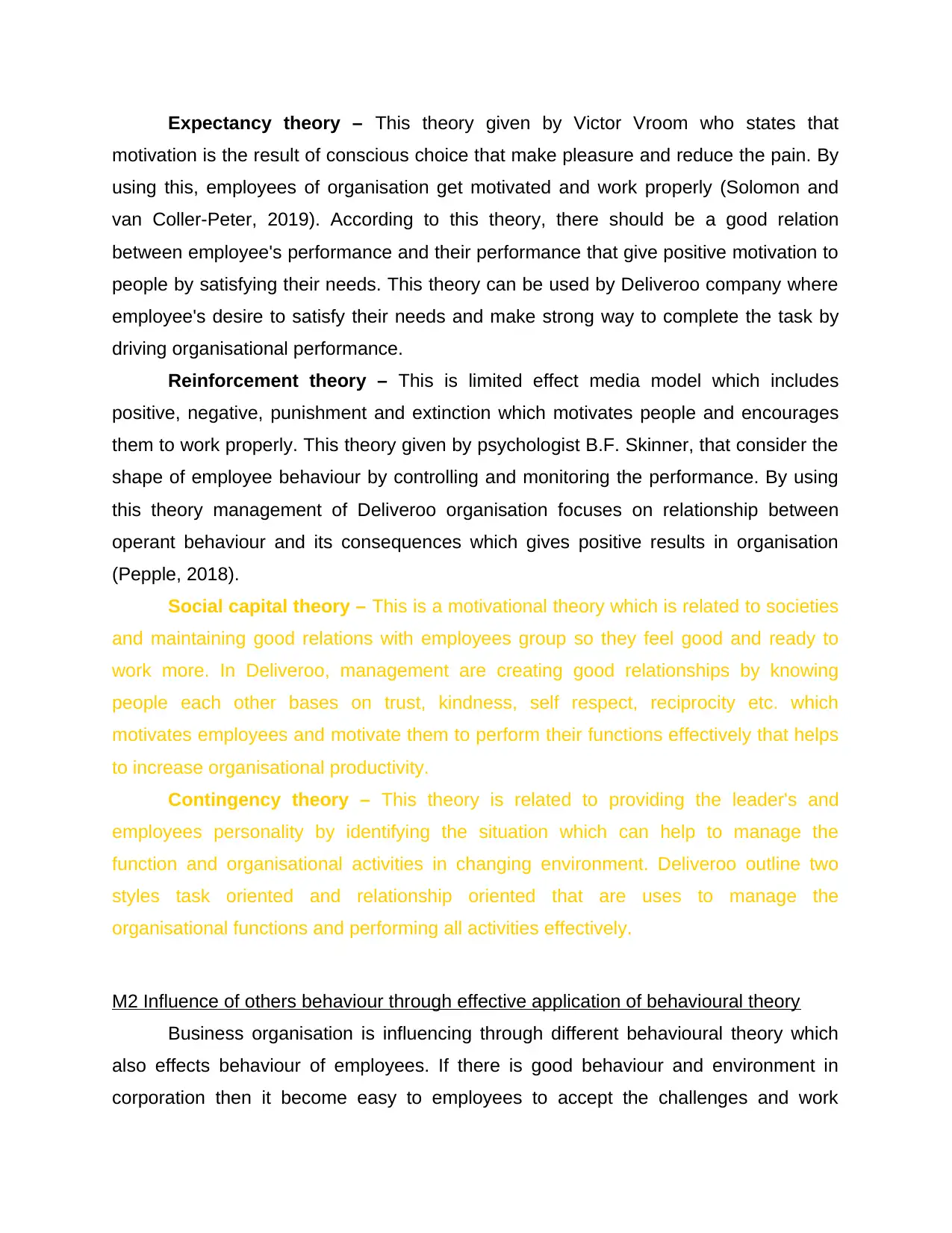
Expectancy theory – This theory given by Victor Vroom who states that
motivation is the result of conscious choice that make pleasure and reduce the pain. By
using this, employees of organisation get motivated and work properly (Solomon and
van Coller-Peter, 2019). According to this theory, there should be a good relation
between employee's performance and their performance that give positive motivation to
people by satisfying their needs. This theory can be used by Deliveroo company where
employee's desire to satisfy their needs and make strong way to complete the task by
driving organisational performance.
Reinforcement theory – This is limited effect media model which includes
positive, negative, punishment and extinction which motivates people and encourages
them to work properly. This theory given by psychologist B.F. Skinner, that consider the
shape of employee behaviour by controlling and monitoring the performance. By using
this theory management of Deliveroo organisation focuses on relationship between
operant behaviour and its consequences which gives positive results in organisation
(Pepple, 2018).
Social capital theory – This is a motivational theory which is related to societies
and maintaining good relations with employees group so they feel good and ready to
work more. In Deliveroo, management are creating good relationships by knowing
people each other bases on trust, kindness, self respect, reciprocity etc. which
motivates employees and motivate them to perform their functions effectively that helps
to increase organisational productivity.
Contingency theory – This theory is related to providing the leader's and
employees personality by identifying the situation which can help to manage the
function and organisational activities in changing environment. Deliveroo outline two
styles task oriented and relationship oriented that are uses to manage the
organisational functions and performing all activities effectively.
M2 Influence of others behaviour through effective application of behavioural theory
Business organisation is influencing through different behavioural theory which
also effects behaviour of employees. If there is good behaviour and environment in
corporation then it become easy to employees to accept the challenges and work
motivation is the result of conscious choice that make pleasure and reduce the pain. By
using this, employees of organisation get motivated and work properly (Solomon and
van Coller-Peter, 2019). According to this theory, there should be a good relation
between employee's performance and their performance that give positive motivation to
people by satisfying their needs. This theory can be used by Deliveroo company where
employee's desire to satisfy their needs and make strong way to complete the task by
driving organisational performance.
Reinforcement theory – This is limited effect media model which includes
positive, negative, punishment and extinction which motivates people and encourages
them to work properly. This theory given by psychologist B.F. Skinner, that consider the
shape of employee behaviour by controlling and monitoring the performance. By using
this theory management of Deliveroo organisation focuses on relationship between
operant behaviour and its consequences which gives positive results in organisation
(Pepple, 2018).
Social capital theory – This is a motivational theory which is related to societies
and maintaining good relations with employees group so they feel good and ready to
work more. In Deliveroo, management are creating good relationships by knowing
people each other bases on trust, kindness, self respect, reciprocity etc. which
motivates employees and motivate them to perform their functions effectively that helps
to increase organisational productivity.
Contingency theory – This theory is related to providing the leader's and
employees personality by identifying the situation which can help to manage the
function and organisational activities in changing environment. Deliveroo outline two
styles task oriented and relationship oriented that are uses to manage the
organisational functions and performing all activities effectively.
M2 Influence of others behaviour through effective application of behavioural theory
Business organisation is influencing through different behavioural theory which
also effects behaviour of employees. If there is good behaviour and environment in
corporation then it become easy to employees to accept the challenges and work
Secure Best Marks with AI Grader
Need help grading? Try our AI Grader for instant feedback on your assignments.
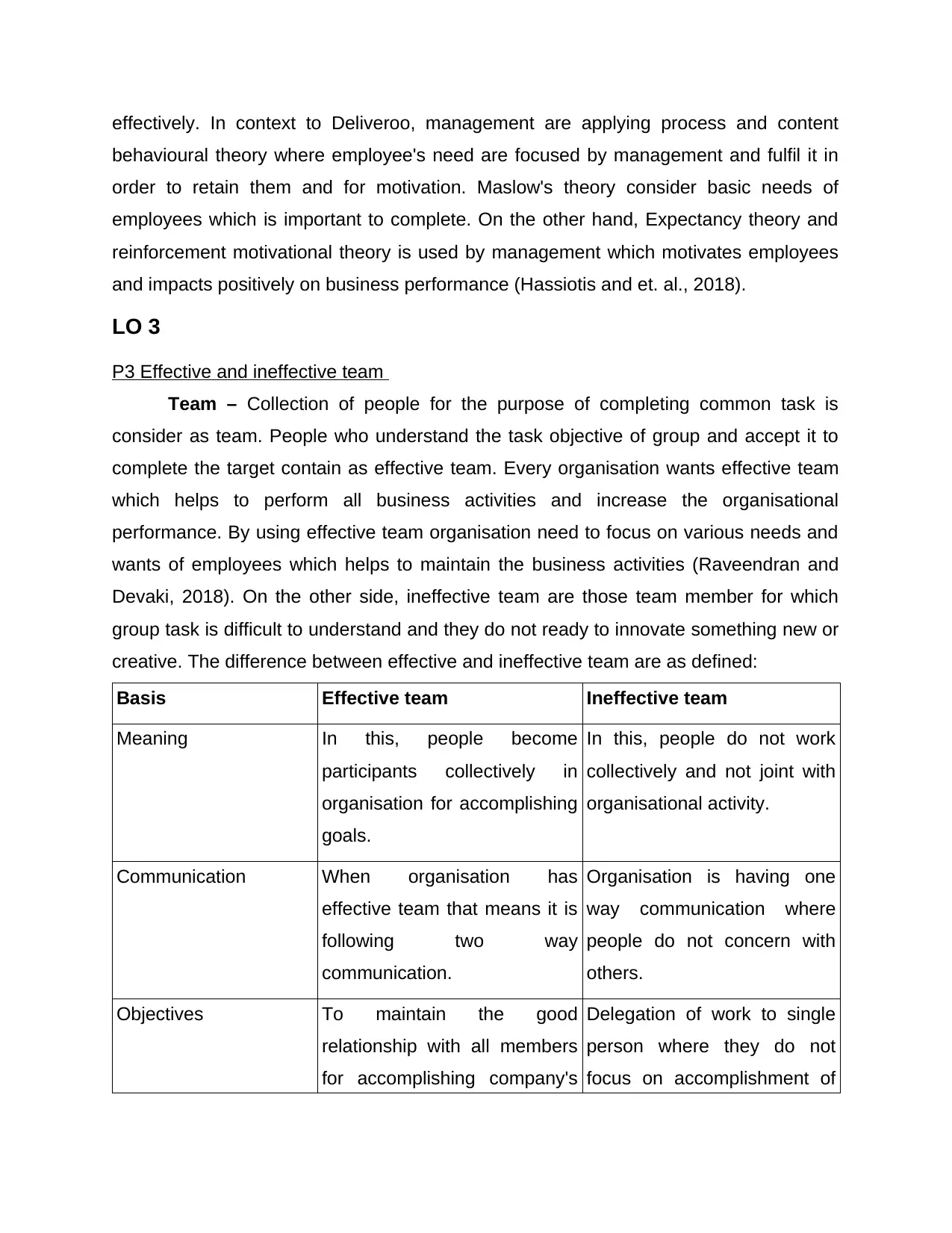
effectively. In context to Deliveroo, management are applying process and content
behavioural theory where employee's need are focused by management and fulfil it in
order to retain them and for motivation. Maslow's theory consider basic needs of
employees which is important to complete. On the other hand, Expectancy theory and
reinforcement motivational theory is used by management which motivates employees
and impacts positively on business performance (Hassiotis and et. al., 2018).
LO 3
P3 Effective and ineffective team
Team – Collection of people for the purpose of completing common task is
consider as team. People who understand the task objective of group and accept it to
complete the target contain as effective team. Every organisation wants effective team
which helps to perform all business activities and increase the organisational
performance. By using effective team organisation need to focus on various needs and
wants of employees which helps to maintain the business activities (Raveendran and
Devaki, 2018). On the other side, ineffective team are those team member for which
group task is difficult to understand and they do not ready to innovate something new or
creative. The difference between effective and ineffective team are as defined:
Basis Effective team Ineffective team
Meaning In this, people become
participants collectively in
organisation for accomplishing
goals.
In this, people do not work
collectively and not joint with
organisational activity.
Communication When organisation has
effective team that means it is
following two way
communication.
Organisation is having one
way communication where
people do not concern with
others.
Objectives To maintain the good
relationship with all members
for accomplishing company's
Delegation of work to single
person where they do not
focus on accomplishment of
behavioural theory where employee's need are focused by management and fulfil it in
order to retain them and for motivation. Maslow's theory consider basic needs of
employees which is important to complete. On the other hand, Expectancy theory and
reinforcement motivational theory is used by management which motivates employees
and impacts positively on business performance (Hassiotis and et. al., 2018).
LO 3
P3 Effective and ineffective team
Team – Collection of people for the purpose of completing common task is
consider as team. People who understand the task objective of group and accept it to
complete the target contain as effective team. Every organisation wants effective team
which helps to perform all business activities and increase the organisational
performance. By using effective team organisation need to focus on various needs and
wants of employees which helps to maintain the business activities (Raveendran and
Devaki, 2018). On the other side, ineffective team are those team member for which
group task is difficult to understand and they do not ready to innovate something new or
creative. The difference between effective and ineffective team are as defined:
Basis Effective team Ineffective team
Meaning In this, people become
participants collectively in
organisation for accomplishing
goals.
In this, people do not work
collectively and not joint with
organisational activity.
Communication When organisation has
effective team that means it is
following two way
communication.
Organisation is having one
way communication where
people do not concern with
others.
Objectives To maintain the good
relationship with all members
for accomplishing company's
Delegation of work to single
person where they do not
focus on accomplishment of
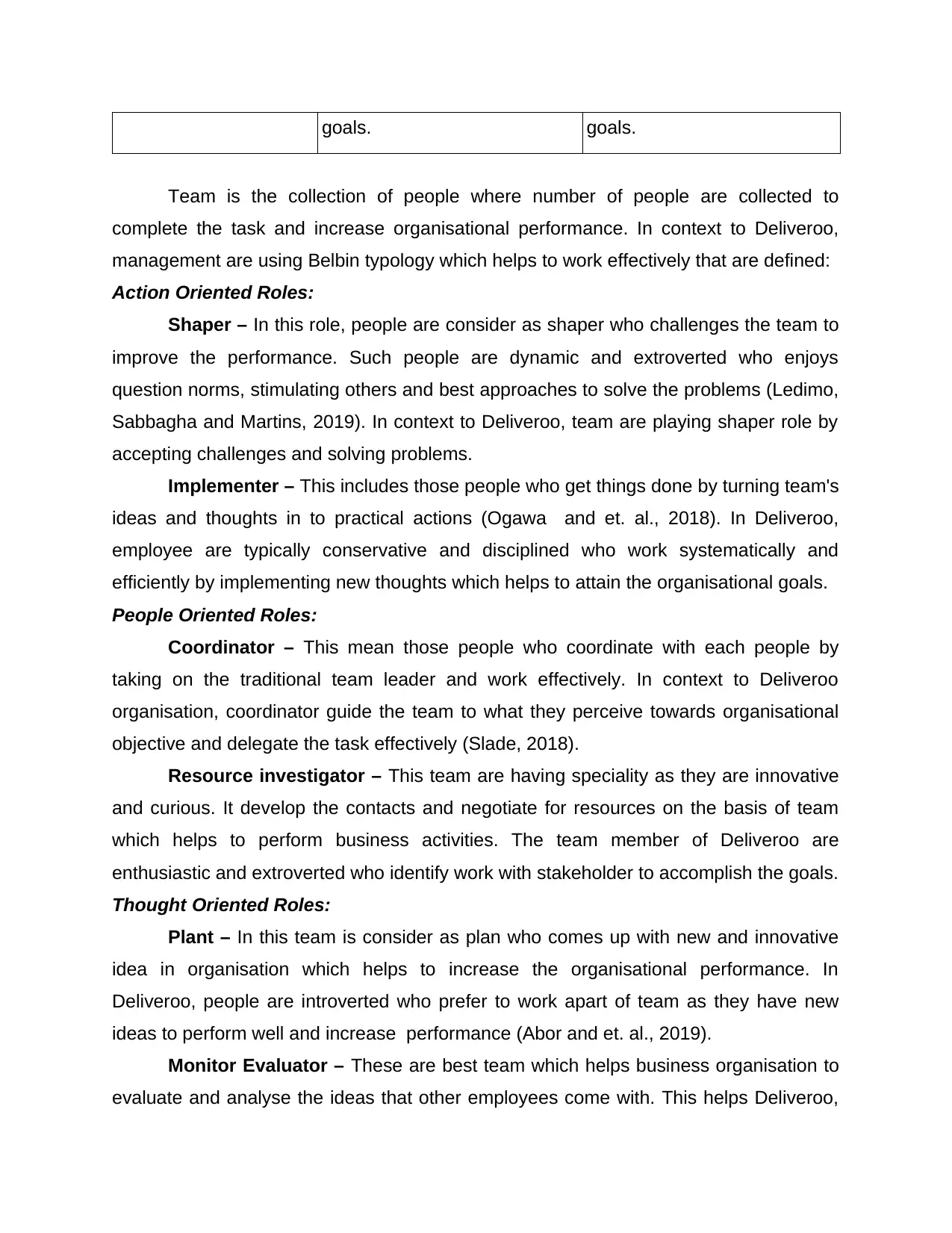
goals. goals.
Team is the collection of people where number of people are collected to
complete the task and increase organisational performance. In context to Deliveroo,
management are using Belbin typology which helps to work effectively that are defined:
Action Oriented Roles:
Shaper – In this role, people are consider as shaper who challenges the team to
improve the performance. Such people are dynamic and extroverted who enjoys
question norms, stimulating others and best approaches to solve the problems (Ledimo,
Sabbagha and Martins, 2019). In context to Deliveroo, team are playing shaper role by
accepting challenges and solving problems.
Implementer – This includes those people who get things done by turning team's
ideas and thoughts in to practical actions (Ogawa and et. al., 2018). In Deliveroo,
employee are typically conservative and disciplined who work systematically and
efficiently by implementing new thoughts which helps to attain the organisational goals.
People Oriented Roles:
Coordinator – This mean those people who coordinate with each people by
taking on the traditional team leader and work effectively. In context to Deliveroo
organisation, coordinator guide the team to what they perceive towards organisational
objective and delegate the task effectively (Slade, 2018).
Resource investigator – This team are having speciality as they are innovative
and curious. It develop the contacts and negotiate for resources on the basis of team
which helps to perform business activities. The team member of Deliveroo are
enthusiastic and extroverted who identify work with stakeholder to accomplish the goals.
Thought Oriented Roles:
Plant – In this team is consider as plan who comes up with new and innovative
idea in organisation which helps to increase the organisational performance. In
Deliveroo, people are introverted who prefer to work apart of team as they have new
ideas to perform well and increase performance (Abor and et. al., 2019).
Monitor Evaluator – These are best team which helps business organisation to
evaluate and analyse the ideas that other employees come with. This helps Deliveroo,
Team is the collection of people where number of people are collected to
complete the task and increase organisational performance. In context to Deliveroo,
management are using Belbin typology which helps to work effectively that are defined:
Action Oriented Roles:
Shaper – In this role, people are consider as shaper who challenges the team to
improve the performance. Such people are dynamic and extroverted who enjoys
question norms, stimulating others and best approaches to solve the problems (Ledimo,
Sabbagha and Martins, 2019). In context to Deliveroo, team are playing shaper role by
accepting challenges and solving problems.
Implementer – This includes those people who get things done by turning team's
ideas and thoughts in to practical actions (Ogawa and et. al., 2018). In Deliveroo,
employee are typically conservative and disciplined who work systematically and
efficiently by implementing new thoughts which helps to attain the organisational goals.
People Oriented Roles:
Coordinator – This mean those people who coordinate with each people by
taking on the traditional team leader and work effectively. In context to Deliveroo
organisation, coordinator guide the team to what they perceive towards organisational
objective and delegate the task effectively (Slade, 2018).
Resource investigator – This team are having speciality as they are innovative
and curious. It develop the contacts and negotiate for resources on the basis of team
which helps to perform business activities. The team member of Deliveroo are
enthusiastic and extroverted who identify work with stakeholder to accomplish the goals.
Thought Oriented Roles:
Plant – In this team is consider as plan who comes up with new and innovative
idea in organisation which helps to increase the organisational performance. In
Deliveroo, people are introverted who prefer to work apart of team as they have new
ideas to perform well and increase performance (Abor and et. al., 2019).
Monitor Evaluator – These are best team which helps business organisation to
evaluate and analyse the ideas that other employees come with. This helps Deliveroo,
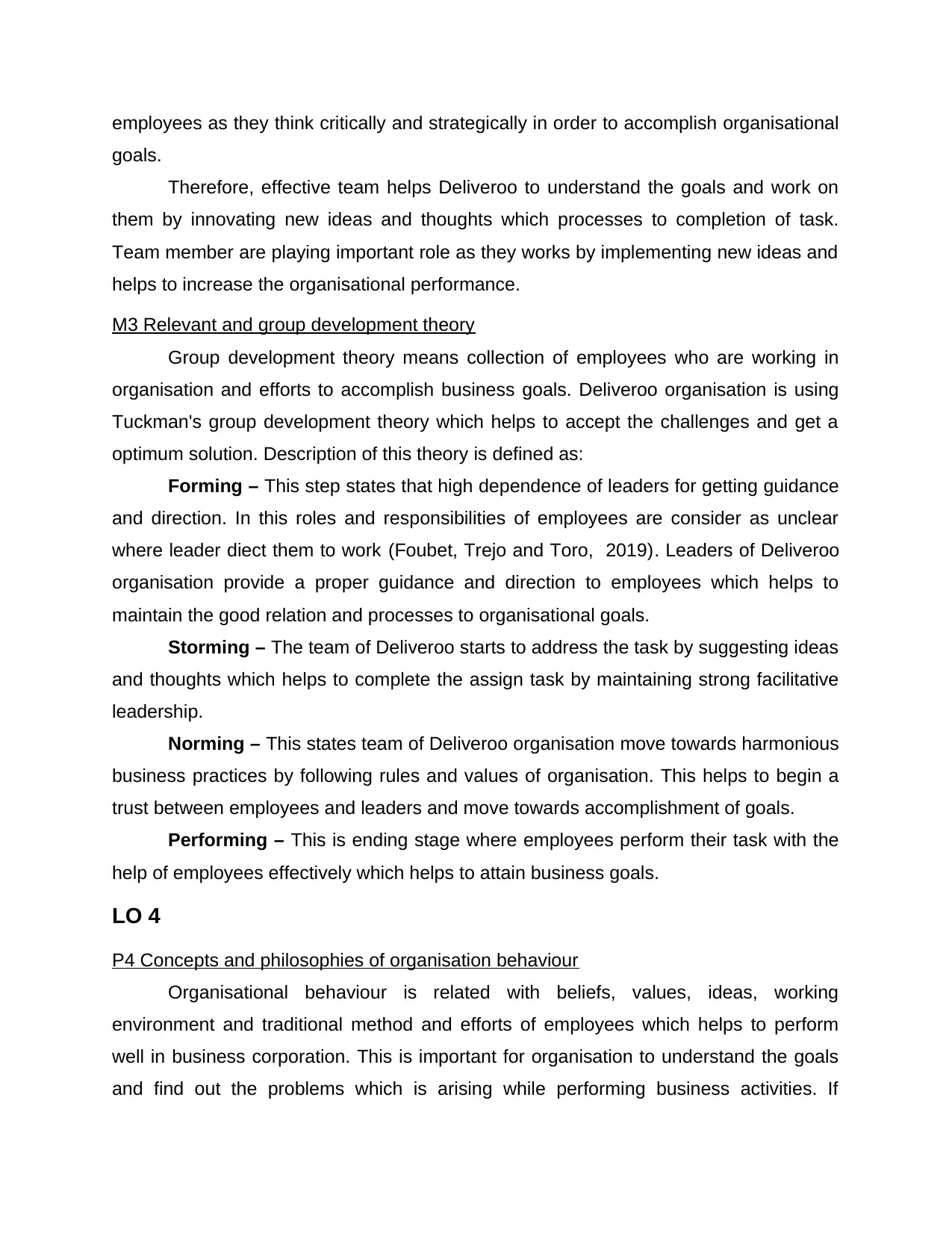
employees as they think critically and strategically in order to accomplish organisational
goals.
Therefore, effective team helps Deliveroo to understand the goals and work on
them by innovating new ideas and thoughts which processes to completion of task.
Team member are playing important role as they works by implementing new ideas and
helps to increase the organisational performance.
M3 Relevant and group development theory
Group development theory means collection of employees who are working in
organisation and efforts to accomplish business goals. Deliveroo organisation is using
Tuckman's group development theory which helps to accept the challenges and get a
optimum solution. Description of this theory is defined as:
Forming – This step states that high dependence of leaders for getting guidance
and direction. In this roles and responsibilities of employees are consider as unclear
where leader diect them to work (Foubet, Trejo and Toro, 2019). Leaders of Deliveroo
organisation provide a proper guidance and direction to employees which helps to
maintain the good relation and processes to organisational goals.
Storming – The team of Deliveroo starts to address the task by suggesting ideas
and thoughts which helps to complete the assign task by maintaining strong facilitative
leadership.
Norming – This states team of Deliveroo organisation move towards harmonious
business practices by following rules and values of organisation. This helps to begin a
trust between employees and leaders and move towards accomplishment of goals.
Performing – This is ending stage where employees perform their task with the
help of employees effectively which helps to attain business goals.
LO 4
P4 Concepts and philosophies of organisation behaviour
Organisational behaviour is related with beliefs, values, ideas, working
environment and traditional method and efforts of employees which helps to perform
well in business corporation. This is important for organisation to understand the goals
and find out the problems which is arising while performing business activities. If
goals.
Therefore, effective team helps Deliveroo to understand the goals and work on
them by innovating new ideas and thoughts which processes to completion of task.
Team member are playing important role as they works by implementing new ideas and
helps to increase the organisational performance.
M3 Relevant and group development theory
Group development theory means collection of employees who are working in
organisation and efforts to accomplish business goals. Deliveroo organisation is using
Tuckman's group development theory which helps to accept the challenges and get a
optimum solution. Description of this theory is defined as:
Forming – This step states that high dependence of leaders for getting guidance
and direction. In this roles and responsibilities of employees are consider as unclear
where leader diect them to work (Foubet, Trejo and Toro, 2019). Leaders of Deliveroo
organisation provide a proper guidance and direction to employees which helps to
maintain the good relation and processes to organisational goals.
Storming – The team of Deliveroo starts to address the task by suggesting ideas
and thoughts which helps to complete the assign task by maintaining strong facilitative
leadership.
Norming – This states team of Deliveroo organisation move towards harmonious
business practices by following rules and values of organisation. This helps to begin a
trust between employees and leaders and move towards accomplishment of goals.
Performing – This is ending stage where employees perform their task with the
help of employees effectively which helps to attain business goals.
LO 4
P4 Concepts and philosophies of organisation behaviour
Organisational behaviour is related with beliefs, values, ideas, working
environment and traditional method and efforts of employees which helps to perform
well in business corporation. This is important for organisation to understand the goals
and find out the problems which is arising while performing business activities. If
Paraphrase This Document
Need a fresh take? Get an instant paraphrase of this document with our AI Paraphraser
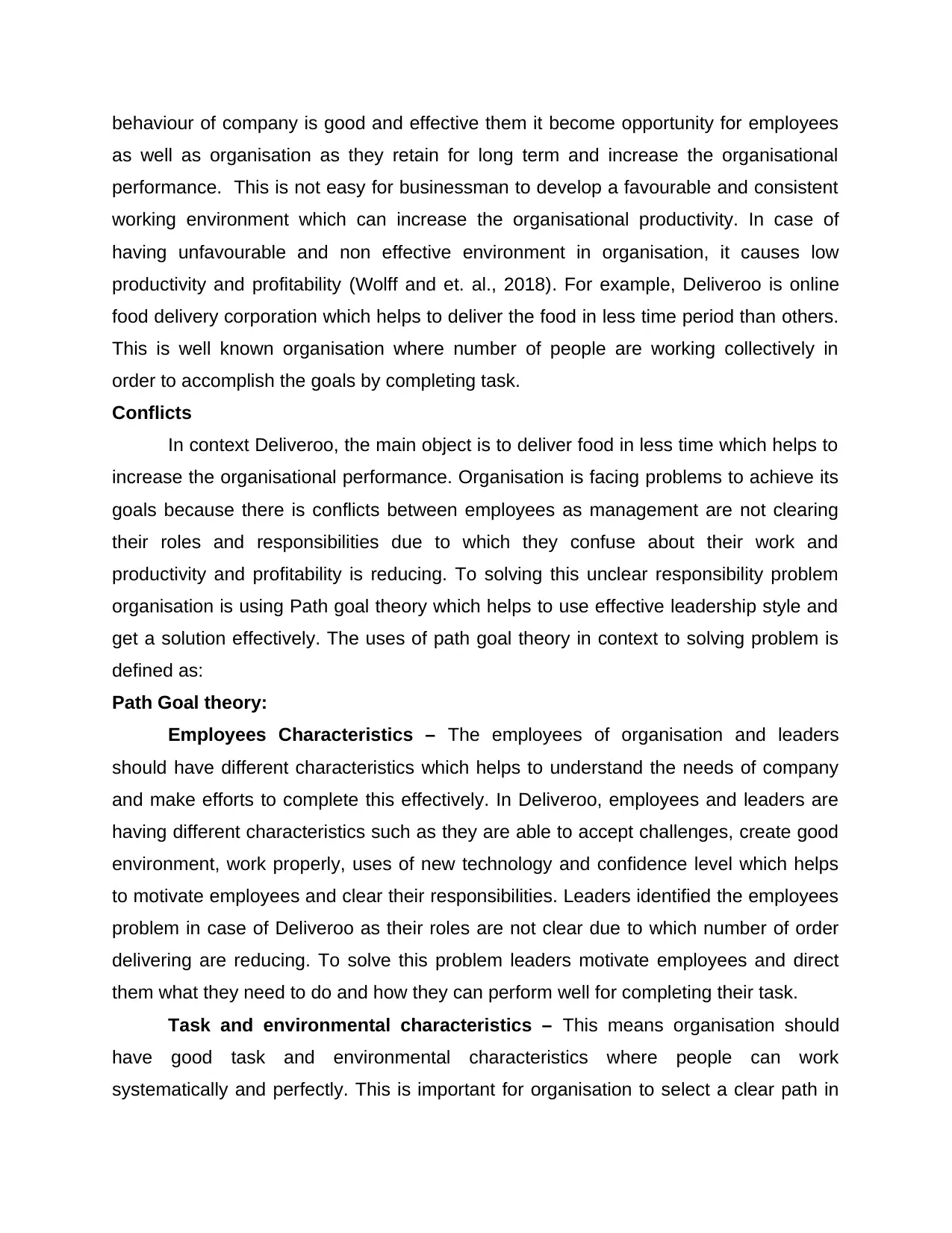
behaviour of company is good and effective them it become opportunity for employees
as well as organisation as they retain for long term and increase the organisational
performance. This is not easy for businessman to develop a favourable and consistent
working environment which can increase the organisational productivity. In case of
having unfavourable and non effective environment in organisation, it causes low
productivity and profitability (Wolff and et. al., 2018). For example, Deliveroo is online
food delivery corporation which helps to deliver the food in less time period than others.
This is well known organisation where number of people are working collectively in
order to accomplish the goals by completing task.
Conflicts
In context Deliveroo, the main object is to deliver food in less time which helps to
increase the organisational performance. Organisation is facing problems to achieve its
goals because there is conflicts between employees as management are not clearing
their roles and responsibilities due to which they confuse about their work and
productivity and profitability is reducing. To solving this unclear responsibility problem
organisation is using Path goal theory which helps to use effective leadership style and
get a solution effectively. The uses of path goal theory in context to solving problem is
defined as:
Path Goal theory:
Employees Characteristics – The employees of organisation and leaders
should have different characteristics which helps to understand the needs of company
and make efforts to complete this effectively. In Deliveroo, employees and leaders are
having different characteristics such as they are able to accept challenges, create good
environment, work properly, uses of new technology and confidence level which helps
to motivate employees and clear their responsibilities. Leaders identified the employees
problem in case of Deliveroo as their roles are not clear due to which number of order
delivering are reducing. To solve this problem leaders motivate employees and direct
them what they need to do and how they can perform well for completing their task.
Task and environmental characteristics – This means organisation should
have good task and environmental characteristics where people can work
systematically and perfectly. This is important for organisation to select a clear path in
as well as organisation as they retain for long term and increase the organisational
performance. This is not easy for businessman to develop a favourable and consistent
working environment which can increase the organisational productivity. In case of
having unfavourable and non effective environment in organisation, it causes low
productivity and profitability (Wolff and et. al., 2018). For example, Deliveroo is online
food delivery corporation which helps to deliver the food in less time period than others.
This is well known organisation where number of people are working collectively in
order to accomplish the goals by completing task.
Conflicts
In context Deliveroo, the main object is to deliver food in less time which helps to
increase the organisational performance. Organisation is facing problems to achieve its
goals because there is conflicts between employees as management are not clearing
their roles and responsibilities due to which they confuse about their work and
productivity and profitability is reducing. To solving this unclear responsibility problem
organisation is using Path goal theory which helps to use effective leadership style and
get a solution effectively. The uses of path goal theory in context to solving problem is
defined as:
Path Goal theory:
Employees Characteristics – The employees of organisation and leaders
should have different characteristics which helps to understand the needs of company
and make efforts to complete this effectively. In Deliveroo, employees and leaders are
having different characteristics such as they are able to accept challenges, create good
environment, work properly, uses of new technology and confidence level which helps
to motivate employees and clear their responsibilities. Leaders identified the employees
problem in case of Deliveroo as their roles are not clear due to which number of order
delivering are reducing. To solve this problem leaders motivate employees and direct
them what they need to do and how they can perform well for completing their task.
Task and environmental characteristics – This means organisation should
have good task and environmental characteristics where people can work
systematically and perfectly. This is important for organisation to select a clear path in
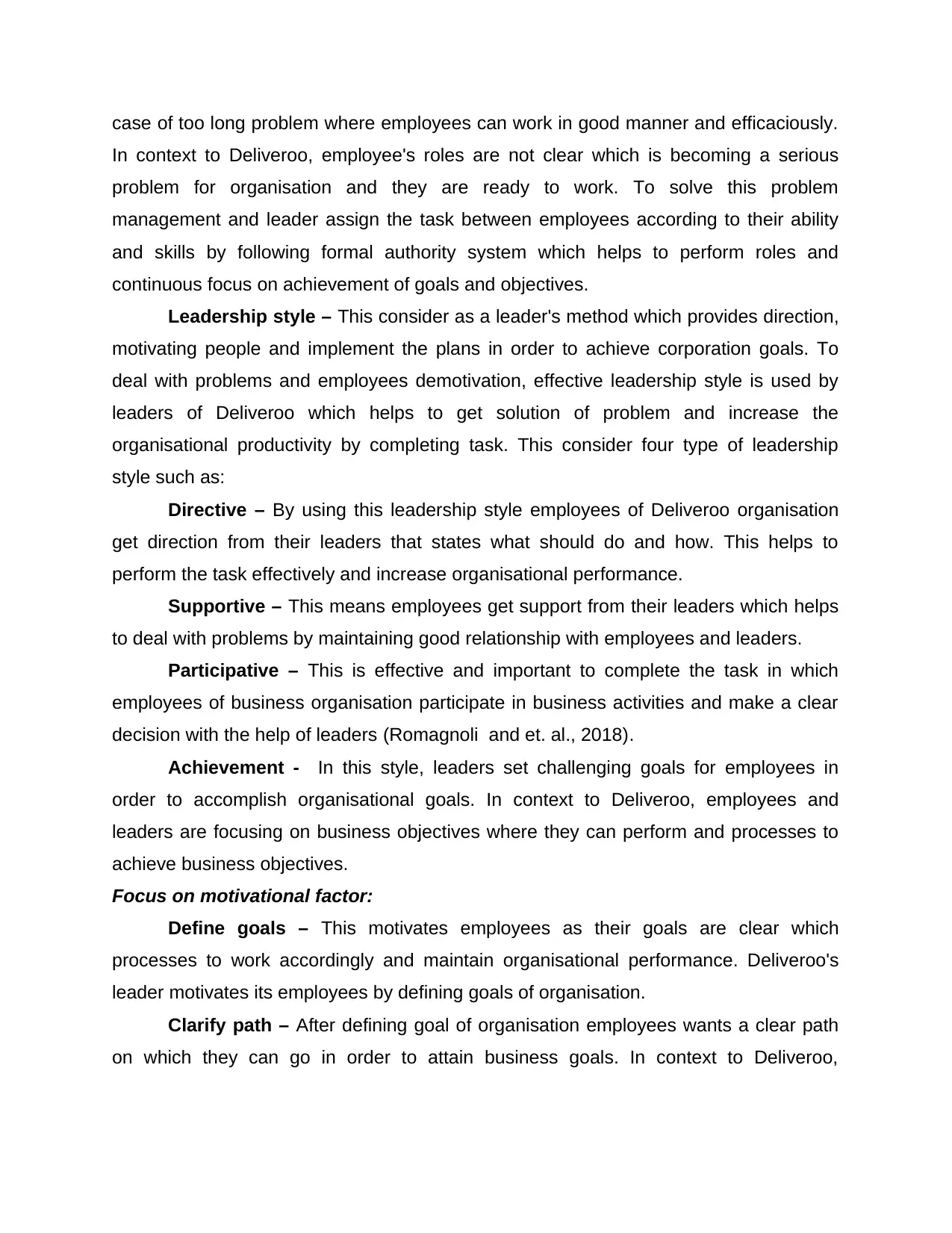
case of too long problem where employees can work in good manner and efficaciously.
In context to Deliveroo, employee's roles are not clear which is becoming a serious
problem for organisation and they are ready to work. To solve this problem
management and leader assign the task between employees according to their ability
and skills by following formal authority system which helps to perform roles and
continuous focus on achievement of goals and objectives.
Leadership style – This consider as a leader's method which provides direction,
motivating people and implement the plans in order to achieve corporation goals. To
deal with problems and employees demotivation, effective leadership style is used by
leaders of Deliveroo which helps to get solution of problem and increase the
organisational productivity by completing task. This consider four type of leadership
style such as:
Directive – By using this leadership style employees of Deliveroo organisation
get direction from their leaders that states what should do and how. This helps to
perform the task effectively and increase organisational performance.
Supportive – This means employees get support from their leaders which helps
to deal with problems by maintaining good relationship with employees and leaders.
Participative – This is effective and important to complete the task in which
employees of business organisation participate in business activities and make a clear
decision with the help of leaders (Romagnoli and et. al., 2018).
Achievement - In this style, leaders set challenging goals for employees in
order to accomplish organisational goals. In context to Deliveroo, employees and
leaders are focusing on business objectives where they can perform and processes to
achieve business objectives.
Focus on motivational factor:
Define goals – This motivates employees as their goals are clear which
processes to work accordingly and maintain organisational performance. Deliveroo's
leader motivates its employees by defining goals of organisation.
Clarify path – After defining goal of organisation employees wants a clear path
on which they can go in order to attain business goals. In context to Deliveroo,
In context to Deliveroo, employee's roles are not clear which is becoming a serious
problem for organisation and they are ready to work. To solve this problem
management and leader assign the task between employees according to their ability
and skills by following formal authority system which helps to perform roles and
continuous focus on achievement of goals and objectives.
Leadership style – This consider as a leader's method which provides direction,
motivating people and implement the plans in order to achieve corporation goals. To
deal with problems and employees demotivation, effective leadership style is used by
leaders of Deliveroo which helps to get solution of problem and increase the
organisational productivity by completing task. This consider four type of leadership
style such as:
Directive – By using this leadership style employees of Deliveroo organisation
get direction from their leaders that states what should do and how. This helps to
perform the task effectively and increase organisational performance.
Supportive – This means employees get support from their leaders which helps
to deal with problems by maintaining good relationship with employees and leaders.
Participative – This is effective and important to complete the task in which
employees of business organisation participate in business activities and make a clear
decision with the help of leaders (Romagnoli and et. al., 2018).
Achievement - In this style, leaders set challenging goals for employees in
order to accomplish organisational goals. In context to Deliveroo, employees and
leaders are focusing on business objectives where they can perform and processes to
achieve business objectives.
Focus on motivational factor:
Define goals – This motivates employees as their goals are clear which
processes to work accordingly and maintain organisational performance. Deliveroo's
leader motivates its employees by defining goals of organisation.
Clarify path – After defining goal of organisation employees wants a clear path
on which they can go in order to attain business goals. In context to Deliveroo,
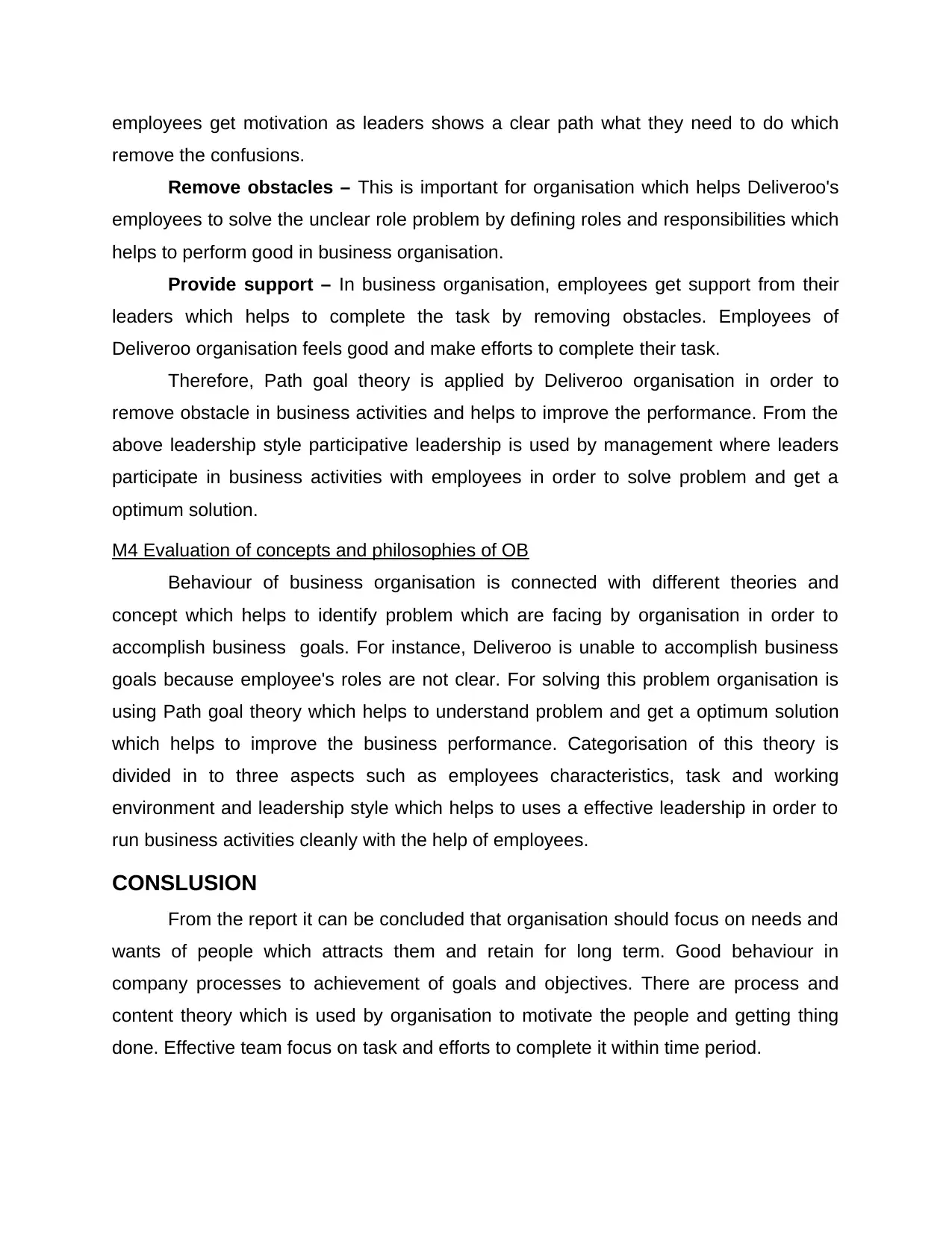
employees get motivation as leaders shows a clear path what they need to do which
remove the confusions.
Remove obstacles – This is important for organisation which helps Deliveroo's
employees to solve the unclear role problem by defining roles and responsibilities which
helps to perform good in business organisation.
Provide support – In business organisation, employees get support from their
leaders which helps to complete the task by removing obstacles. Employees of
Deliveroo organisation feels good and make efforts to complete their task.
Therefore, Path goal theory is applied by Deliveroo organisation in order to
remove obstacle in business activities and helps to improve the performance. From the
above leadership style participative leadership is used by management where leaders
participate in business activities with employees in order to solve problem and get a
optimum solution.
M4 Evaluation of concepts and philosophies of OB
Behaviour of business organisation is connected with different theories and
concept which helps to identify problem which are facing by organisation in order to
accomplish business goals. For instance, Deliveroo is unable to accomplish business
goals because employee's roles are not clear. For solving this problem organisation is
using Path goal theory which helps to understand problem and get a optimum solution
which helps to improve the business performance. Categorisation of this theory is
divided in to three aspects such as employees characteristics, task and working
environment and leadership style which helps to uses a effective leadership in order to
run business activities cleanly with the help of employees.
CONSLUSION
From the report it can be concluded that organisation should focus on needs and
wants of people which attracts them and retain for long term. Good behaviour in
company processes to achievement of goals and objectives. There are process and
content theory which is used by organisation to motivate the people and getting thing
done. Effective team focus on task and efforts to complete it within time period.
remove the confusions.
Remove obstacles – This is important for organisation which helps Deliveroo's
employees to solve the unclear role problem by defining roles and responsibilities which
helps to perform good in business organisation.
Provide support – In business organisation, employees get support from their
leaders which helps to complete the task by removing obstacles. Employees of
Deliveroo organisation feels good and make efforts to complete their task.
Therefore, Path goal theory is applied by Deliveroo organisation in order to
remove obstacle in business activities and helps to improve the performance. From the
above leadership style participative leadership is used by management where leaders
participate in business activities with employees in order to solve problem and get a
optimum solution.
M4 Evaluation of concepts and philosophies of OB
Behaviour of business organisation is connected with different theories and
concept which helps to identify problem which are facing by organisation in order to
accomplish business goals. For instance, Deliveroo is unable to accomplish business
goals because employee's roles are not clear. For solving this problem organisation is
using Path goal theory which helps to understand problem and get a optimum solution
which helps to improve the business performance. Categorisation of this theory is
divided in to three aspects such as employees characteristics, task and working
environment and leadership style which helps to uses a effective leadership in order to
run business activities cleanly with the help of employees.
CONSLUSION
From the report it can be concluded that organisation should focus on needs and
wants of people which attracts them and retain for long term. Good behaviour in
company processes to achievement of goals and objectives. There are process and
content theory which is used by organisation to motivate the people and getting thing
done. Effective team focus on task and efforts to complete it within time period.
Secure Best Marks with AI Grader
Need help grading? Try our AI Grader for instant feedback on your assignments.

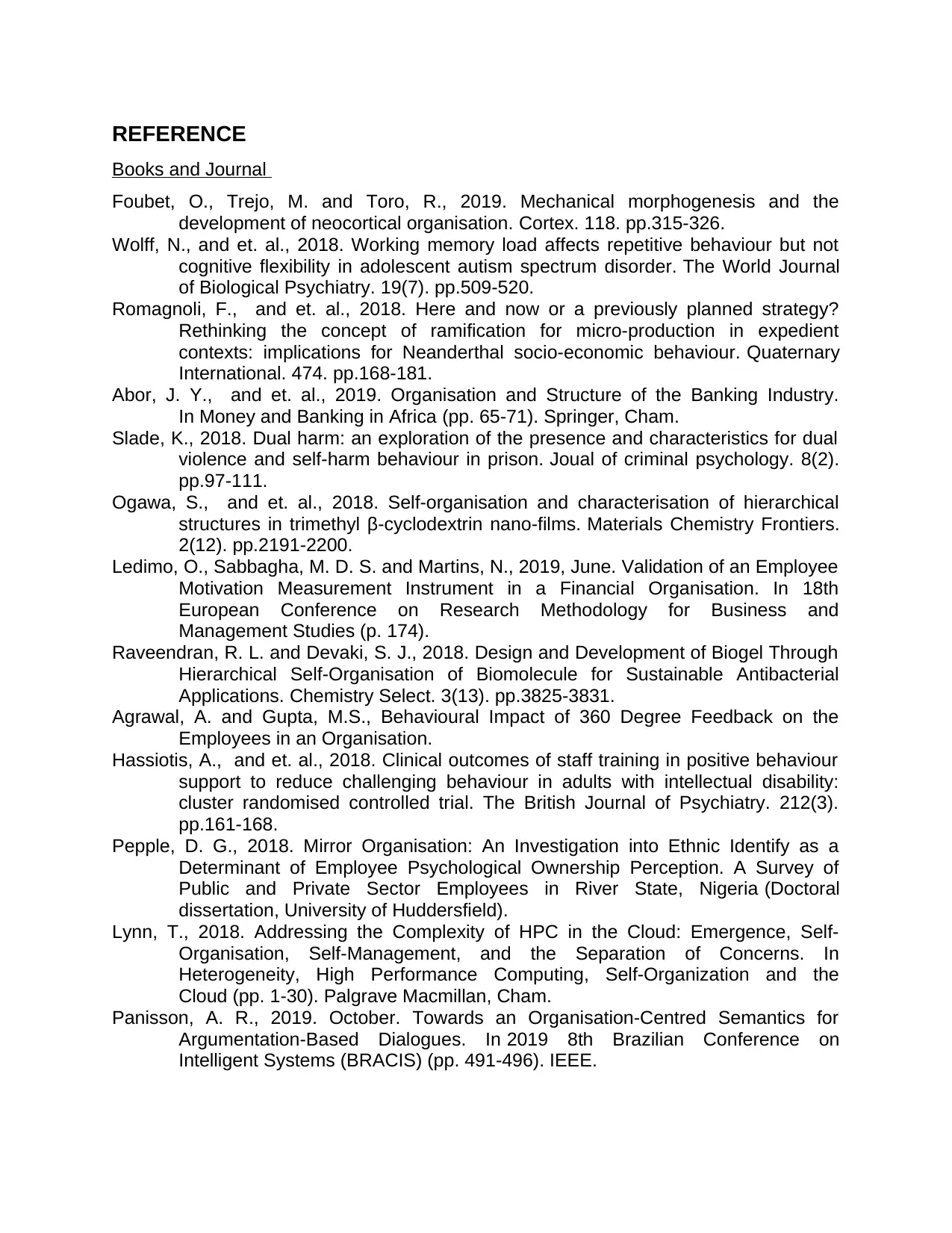
REFERENCE
Books and Journal
Foubet, O., Trejo, M. and Toro, R., 2019. Mechanical morphogenesis and the
development of neocortical organisation. Cortex. 118. pp.315-326.
Wolff, N., and et. al., 2018. Working memory load affects repetitive behaviour but not
cognitive flexibility in adolescent autism spectrum disorder. The World Journal
of Biological Psychiatry. 19(7). pp.509-520.
Romagnoli, F., and et. al., 2018. Here and now or a previously planned strategy?
Rethinking the concept of ramification for micro-production in expedient
contexts: implications for Neanderthal socio-economic behaviour. Quaternary
International. 474. pp.168-181.
Abor, J. Y., and et. al., 2019. Organisation and Structure of the Banking Industry.
In Money and Banking in Africa (pp. 65-71). Springer, Cham.
Slade, K., 2018. Dual harm: an exploration of the presence and characteristics for dual
violence and self-harm behaviour in prison. Joual of criminal psychology. 8(2).
pp.97-111.
Ogawa, S., and et. al., 2018. Self-organisation and characterisation of hierarchical
structures in trimethyl β-cyclodextrin nano-films. Materials Chemistry Frontiers.
2(12). pp.2191-2200.
Ledimo, O., Sabbagha, M. D. S. and Martins, N., 2019, June. Validation of an Employee
Motivation Measurement Instrument in a Financial Organisation. In 18th
European Conference on Research Methodology for Business and
Management Studies (p. 174).
Raveendran, R. L. and Devaki, S. J., 2018. Design and Development of Biogel Through
Hierarchical Self‐Organisation of Biomolecule for Sustainable Antibacterial
Applications. Chemistry Select. 3(13). pp.3825-3831.
Agrawal, A. and Gupta, M.S., Behavioural Impact of 360 Degree Feedback on the
Employees in an Organisation.
Hassiotis, A., and et. al., 2018. Clinical outcomes of staff training in positive behaviour
support to reduce challenging behaviour in adults with intellectual disability:
cluster randomised controlled trial. The British Journal of Psychiatry. 212(3).
pp.161-168.
Pepple, D. G., 2018. Mirror Organisation: An Investigation into Ethnic Identify as a
Determinant of Employee Psychological Ownership Perception. A Survey of
Public and Private Sector Employees in River State, Nigeria (Doctoral
dissertation, University of Huddersfield).
Lynn, T., 2018. Addressing the Complexity of HPC in the Cloud: Emergence, Self-
Organisation, Self-Management, and the Separation of Concerns. In
Heterogeneity, High Performance Computing, Self-Organization and the
Cloud (pp. 1-30). Palgrave Macmillan, Cham.
Panisson, A. R., 2019. October. Towards an Organisation-Centred Semantics for
Argumentation-Based Dialogues. In 2019 8th Brazilian Conference on
Intelligent Systems (BRACIS) (pp. 491-496). IEEE.
Books and Journal
Foubet, O., Trejo, M. and Toro, R., 2019. Mechanical morphogenesis and the
development of neocortical organisation. Cortex. 118. pp.315-326.
Wolff, N., and et. al., 2018. Working memory load affects repetitive behaviour but not
cognitive flexibility in adolescent autism spectrum disorder. The World Journal
of Biological Psychiatry. 19(7). pp.509-520.
Romagnoli, F., and et. al., 2018. Here and now or a previously planned strategy?
Rethinking the concept of ramification for micro-production in expedient
contexts: implications for Neanderthal socio-economic behaviour. Quaternary
International. 474. pp.168-181.
Abor, J. Y., and et. al., 2019. Organisation and Structure of the Banking Industry.
In Money and Banking in Africa (pp. 65-71). Springer, Cham.
Slade, K., 2018. Dual harm: an exploration of the presence and characteristics for dual
violence and self-harm behaviour in prison. Joual of criminal psychology. 8(2).
pp.97-111.
Ogawa, S., and et. al., 2018. Self-organisation and characterisation of hierarchical
structures in trimethyl β-cyclodextrin nano-films. Materials Chemistry Frontiers.
2(12). pp.2191-2200.
Ledimo, O., Sabbagha, M. D. S. and Martins, N., 2019, June. Validation of an Employee
Motivation Measurement Instrument in a Financial Organisation. In 18th
European Conference on Research Methodology for Business and
Management Studies (p. 174).
Raveendran, R. L. and Devaki, S. J., 2018. Design and Development of Biogel Through
Hierarchical Self‐Organisation of Biomolecule for Sustainable Antibacterial
Applications. Chemistry Select. 3(13). pp.3825-3831.
Agrawal, A. and Gupta, M.S., Behavioural Impact of 360 Degree Feedback on the
Employees in an Organisation.
Hassiotis, A., and et. al., 2018. Clinical outcomes of staff training in positive behaviour
support to reduce challenging behaviour in adults with intellectual disability:
cluster randomised controlled trial. The British Journal of Psychiatry. 212(3).
pp.161-168.
Pepple, D. G., 2018. Mirror Organisation: An Investigation into Ethnic Identify as a
Determinant of Employee Psychological Ownership Perception. A Survey of
Public and Private Sector Employees in River State, Nigeria (Doctoral
dissertation, University of Huddersfield).
Lynn, T., 2018. Addressing the Complexity of HPC in the Cloud: Emergence, Self-
Organisation, Self-Management, and the Separation of Concerns. In
Heterogeneity, High Performance Computing, Self-Organization and the
Cloud (pp. 1-30). Palgrave Macmillan, Cham.
Panisson, A. R., 2019. October. Towards an Organisation-Centred Semantics for
Argumentation-Based Dialogues. In 2019 8th Brazilian Conference on
Intelligent Systems (BRACIS) (pp. 491-496). IEEE.
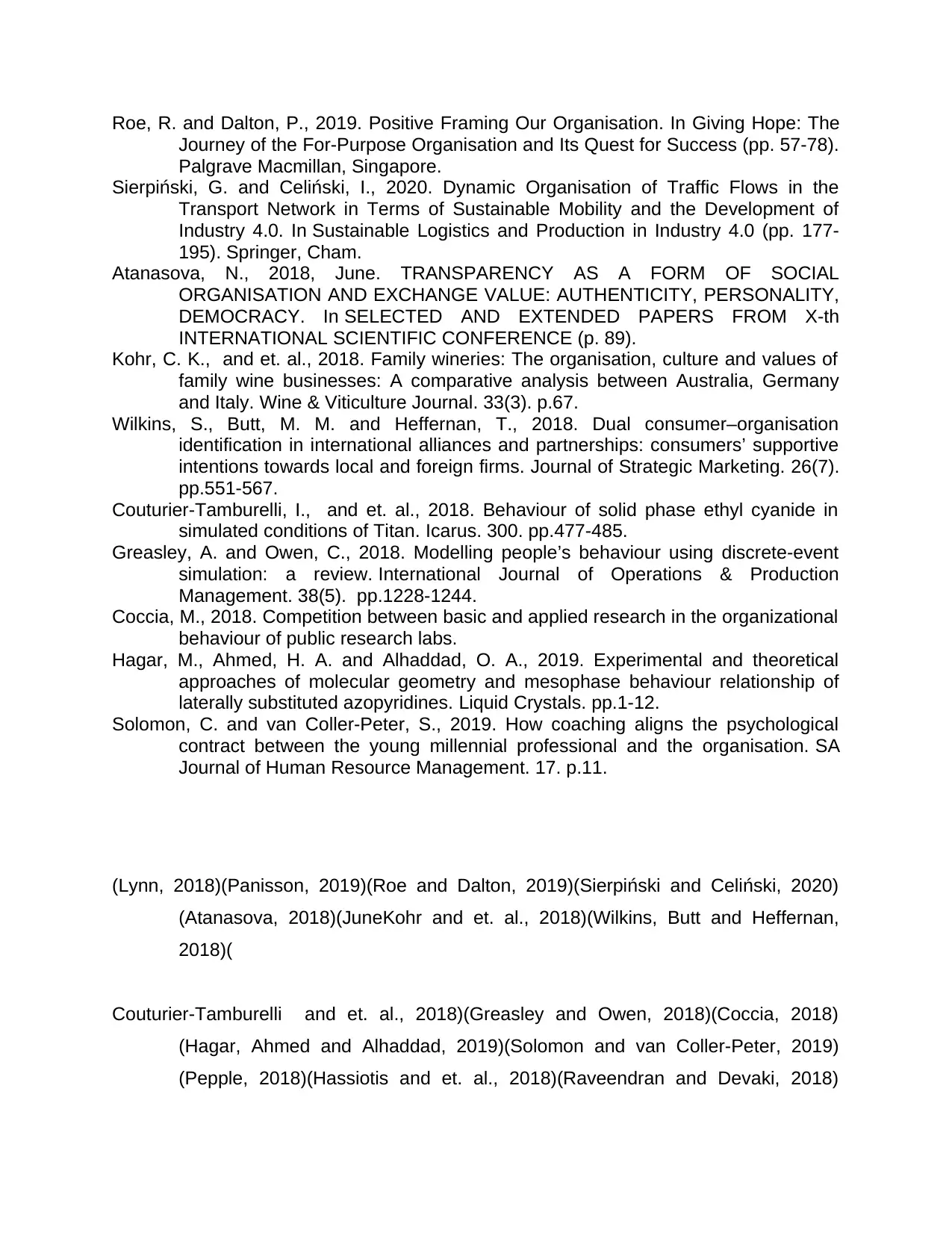
Roe, R. and Dalton, P., 2019. Positive Framing Our Organisation. In Giving Hope: The
Journey of the For-Purpose Organisation and Its Quest for Success (pp. 57-78).
Palgrave Macmillan, Singapore.
Sierpiński, G. and Celiński, I., 2020. Dynamic Organisation of Traffic Flows in the
Transport Network in Terms of Sustainable Mobility and the Development of
Industry 4.0. In Sustainable Logistics and Production in Industry 4.0 (pp. 177-
195). Springer, Cham.
Atanasova, N., 2018, June. TRANSPARENCY AS A FORM OF SOCIAL
ORGANISATION AND EXCHANGE VALUE: AUTHENTICITY, PERSONALITY,
DEMOCRACY. In SELECTED AND EXTENDED PAPERS FROM X-th
INTERNATIONAL SCIENTIFIC CONFERENCE (p. 89).
Kohr, C. K., and et. al., 2018. Family wineries: The organisation, culture and values of
family wine businesses: A comparative analysis between Australia, Germany
and Italy. Wine & Viticulture Journal. 33(3). p.67.
Wilkins, S., Butt, M. M. and Heffernan, T., 2018. Dual consumer–organisation
identification in international alliances and partnerships: consumers’ supportive
intentions towards local and foreign firms. Journal of Strategic Marketing. 26(7).
pp.551-567.
Couturier-Tamburelli, I., and et. al., 2018. Behaviour of solid phase ethyl cyanide in
simulated conditions of Titan. Icarus. 300. pp.477-485.
Greasley, A. and Owen, C., 2018. Modelling people’s behaviour using discrete-event
simulation: a review. International Journal of Operations & Production
Management. 38(5). pp.1228-1244.
Coccia, M., 2018. Competition between basic and applied research in the organizational
behaviour of public research labs.
Hagar, M., Ahmed, H. A. and Alhaddad, O. A., 2019. Experimental and theoretical
approaches of molecular geometry and mesophase behaviour relationship of
laterally substituted azopyridines. Liquid Crystals. pp.1-12.
Solomon, C. and van Coller-Peter, S., 2019. How coaching aligns the psychological
contract between the young millennial professional and the organisation. SA
Journal of Human Resource Management. 17. p.11.
(Lynn, 2018)(Panisson, 2019)(Roe and Dalton, 2019)(Sierpiński and Celiński, 2020)
(Atanasova, 2018)(JuneKohr and et. al., 2018)(Wilkins, Butt and Heffernan,
2018)(
Couturier-Tamburelli and et. al., 2018)(Greasley and Owen, 2018)(Coccia, 2018)
(Hagar, Ahmed and Alhaddad, 2019)(Solomon and van Coller-Peter, 2019)
(Pepple, 2018)(Hassiotis and et. al., 2018)(Raveendran and Devaki, 2018)
Journey of the For-Purpose Organisation and Its Quest for Success (pp. 57-78).
Palgrave Macmillan, Singapore.
Sierpiński, G. and Celiński, I., 2020. Dynamic Organisation of Traffic Flows in the
Transport Network in Terms of Sustainable Mobility and the Development of
Industry 4.0. In Sustainable Logistics and Production in Industry 4.0 (pp. 177-
195). Springer, Cham.
Atanasova, N., 2018, June. TRANSPARENCY AS A FORM OF SOCIAL
ORGANISATION AND EXCHANGE VALUE: AUTHENTICITY, PERSONALITY,
DEMOCRACY. In SELECTED AND EXTENDED PAPERS FROM X-th
INTERNATIONAL SCIENTIFIC CONFERENCE (p. 89).
Kohr, C. K., and et. al., 2018. Family wineries: The organisation, culture and values of
family wine businesses: A comparative analysis between Australia, Germany
and Italy. Wine & Viticulture Journal. 33(3). p.67.
Wilkins, S., Butt, M. M. and Heffernan, T., 2018. Dual consumer–organisation
identification in international alliances and partnerships: consumers’ supportive
intentions towards local and foreign firms. Journal of Strategic Marketing. 26(7).
pp.551-567.
Couturier-Tamburelli, I., and et. al., 2018. Behaviour of solid phase ethyl cyanide in
simulated conditions of Titan. Icarus. 300. pp.477-485.
Greasley, A. and Owen, C., 2018. Modelling people’s behaviour using discrete-event
simulation: a review. International Journal of Operations & Production
Management. 38(5). pp.1228-1244.
Coccia, M., 2018. Competition between basic and applied research in the organizational
behaviour of public research labs.
Hagar, M., Ahmed, H. A. and Alhaddad, O. A., 2019. Experimental and theoretical
approaches of molecular geometry and mesophase behaviour relationship of
laterally substituted azopyridines. Liquid Crystals. pp.1-12.
Solomon, C. and van Coller-Peter, S., 2019. How coaching aligns the psychological
contract between the young millennial professional and the organisation. SA
Journal of Human Resource Management. 17. p.11.
(Lynn, 2018)(Panisson, 2019)(Roe and Dalton, 2019)(Sierpiński and Celiński, 2020)
(Atanasova, 2018)(JuneKohr and et. al., 2018)(Wilkins, Butt and Heffernan,
2018)(
Couturier-Tamburelli and et. al., 2018)(Greasley and Owen, 2018)(Coccia, 2018)
(Hagar, Ahmed and Alhaddad, 2019)(Solomon and van Coller-Peter, 2019)
(Pepple, 2018)(Hassiotis and et. al., 2018)(Raveendran and Devaki, 2018)
Paraphrase This Document
Need a fresh take? Get an instant paraphrase of this document with our AI Paraphraser
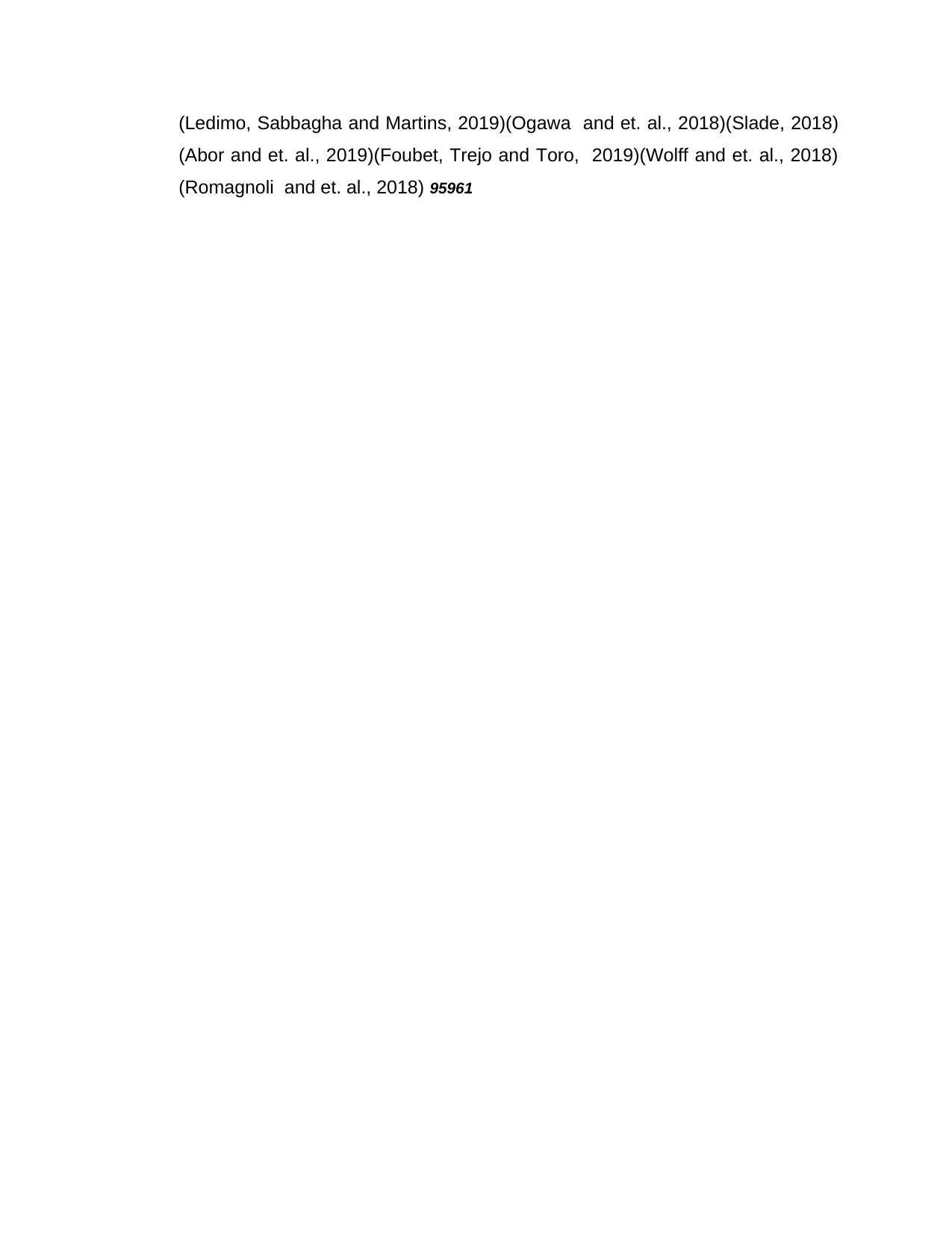
(Ledimo, Sabbagha and Martins, 2019)(Ogawa and et. al., 2018)(Slade, 2018)
(Abor and et. al., 2019)(Foubet, Trejo and Toro, 2019)(Wolff and et. al., 2018)
(Romagnoli and et. al., 2018) 95961
(Abor and et. al., 2019)(Foubet, Trejo and Toro, 2019)(Wolff and et. al., 2018)
(Romagnoli and et. al., 2018) 95961
1 out of 20
Related Documents
Your All-in-One AI-Powered Toolkit for Academic Success.
+13062052269
info@desklib.com
Available 24*7 on WhatsApp / Email
![[object Object]](/_next/static/media/star-bottom.7253800d.svg)
Unlock your academic potential
© 2024 | Zucol Services PVT LTD | All rights reserved.





